Isabel (S. P. 521)
1917-1946
The Navy retained the name carried by this ship at the time of her acquisition.
(S. P. 521; displacement 710; length 245'3"; beam 27'9"; draft 8'6"; speed 26 knots; complement 103; armament 4 3-inch, 2 18-inch torpedo tubes, 1 depth charge projector, 2 Lewis machine guns)
Isabel -- a yacht, built in 1917 by Bath Iron Works, Bath, Maine, was acquired by the Navy before completion, from her owner, automobile manufacturer John North Willys of Toledo, Ohio; converted to Navy use as a “destroyer leader” and given the identification number S. P. 521; commissioned at the Boston [Mass.] Navy Yard on 28 December 1917, Lt. Cmdr. Harry E. Shoemaker in command.
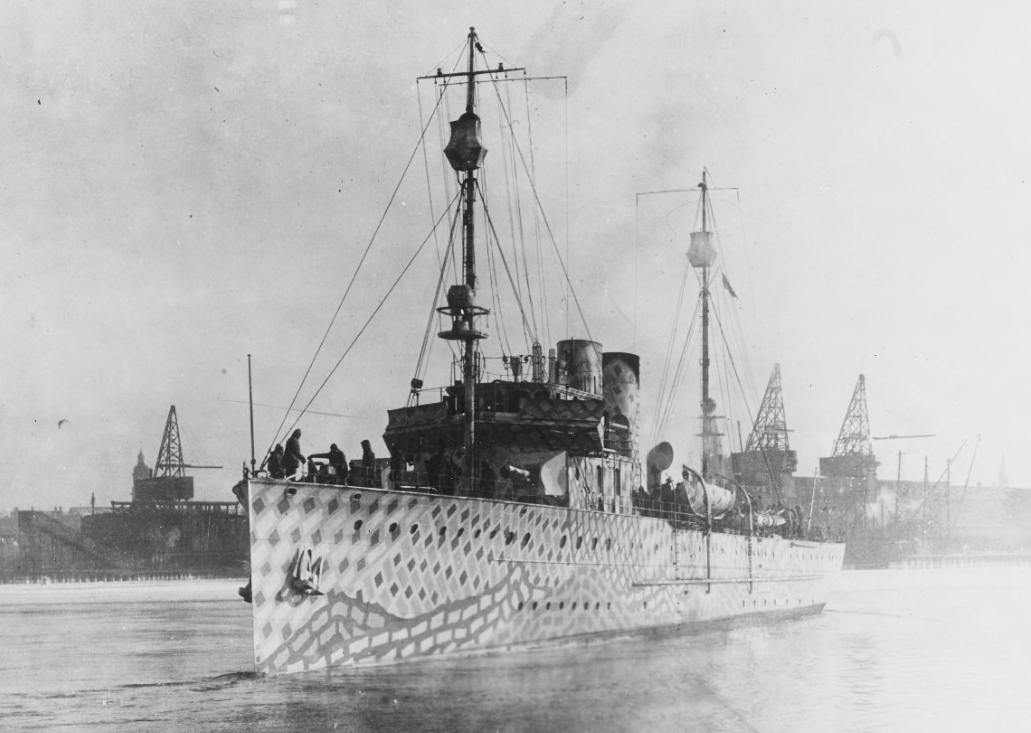
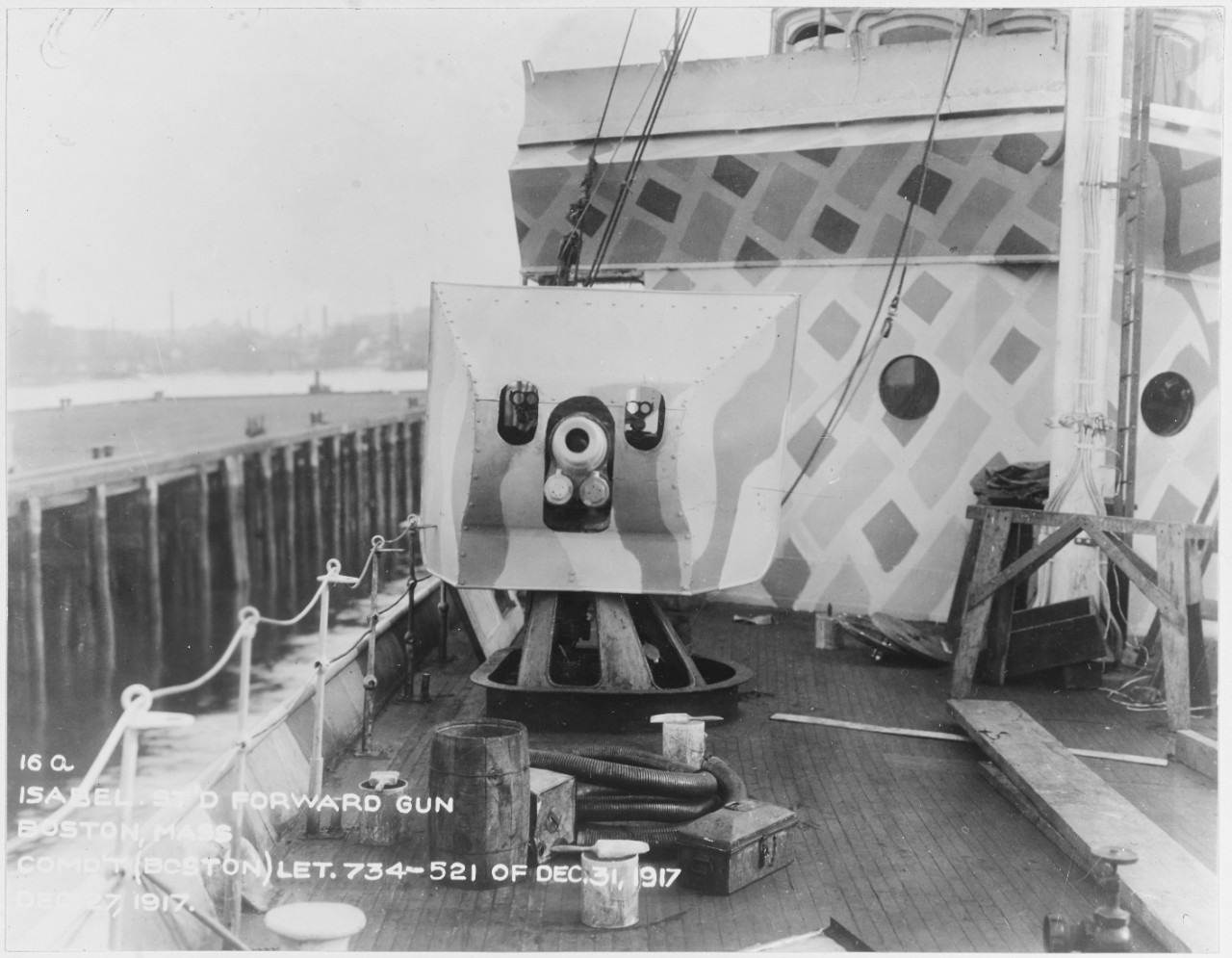
Isabel cleared the Boston Navy Yard on 6 January 1918 and steamed to Newport, R.I. (Base No. 12) arriving that same day. She then got underway on 8 January and arrived the next day at Tompkinsville (Staten Island), N.Y. (Base No. 21). On 10 January, she shifted to the New York Navy Yard to prepare for distant service. Undocking on 23 January, she cleared the yard, briefly touched at Tompkinsville, and went to sea en route to Europe that same day. She arrived at Bermuda (Base No. 24) on 25 January. After four days, the ship got underway bound for the Azores (Base No. 13) where she arrived on 4 February. Isabel remained at the Portuguese possession until 16 February. During this time, she underwent five days of overhaul.
Underway again at 11:50 a.m. on 15 February 1918 having set a course for what was to become her home base, Brest, France (Base No. 7). She was to meet up with Prometheus (Repair Ship No. 2) en route. While underway on 17 February, Reid (Destroyer No. 21) intercepted a message from MacDonough (Torpedo Boat Destroyer No. 9) stating that she had insufficient fuel to make Brest and needed assistance. Reid responded and met her about 160 miles from Brest. Unable to tow her alone, Reid radioed Brest for assistance. Drayton (Destroyer No. 23) and McCall (Destroyer No.28) were dispatched. The destroyers met the ships on 19 February, and Drayton and Isabel took MacDonough under tow. After a period of time, Isabel cast off the tow and conducted patrol into Brest. All arrived the next day. Reporting for duty with the Patrol Forces, U.S. Naval Forces in France, under the command of Rear Adm. Henry B. Wilson, Isabel was soon underway conducting convoy escort and antisubmarine patrol missions.
Isabel sortied with Reid, Smith (Destroyer No. 17), Flusser (Destroyer No. 20), and Warrington (Destroyer No. 30) escorting troop transports Covington (Id. No. 1409) and George Washington (Id. No. 3018) on 10 March. The next day the yacht parted from the convoy in heavy weather and maneuvered to rendezvous with an eastbound 18-ship convoy bound for England. She escorted the inbound convoy a short distance and then returned to Brest.
Isabel sortied with Warrington, Reid, and Flusser at 4:00 p.m. on 16 March 1918, to escort Seattle (Armored Cruiser No. 11), Rappahannock (Id. No. 1854), and President Grant westward. The convoy separated, Warrington and Flusser accompanying Seattle southwest and Reid and Isabel remaining with Rappahannock and President Grant. The two remained with the transports until noon on the 17th, when both went after an eastbound convoy. Underway in rough weather, Reid had turbine trouble and was forced to "lay to" for 40 minutes. At 3:45 p.m., they sighted the convoy and exchanged signals with Chester (Cruiser No. 2). At 9:00 p.m., the destroyers parted with the convoy for Brest, Isabel accompanying as senior.
While en route on the morning of 18 March 1918, Isabel and Reid passed the British tramp steamer Roath, steaming alone at 8:30 a.m. Just over two hours later, at 10:54 a.m., Lt. Cmdr. Slayton, the Reid’s commanding officer, sighted a submarine, UC-48 (Oberleutnant zur See Helmut Lorenz commanding), from his position on the bridge. He ordered full speed and called all hands to general quarters. A signal had been sent to Isabel, that held position on Reid’s port quarter, not less than a mile distant. On putting on extra speed, Reid tooted her whistle six times, as a submarine warning. After Reid and Isabel had covered about a mile, the U-boat commander folded his wireless masts and submerged in two minutes. Slayton had held gunfire in the hope of getting into a better position for placing depth charges. He had also changed course to avoid steaming between the sun and the submarine, where Reid would have been more outlined against the sky. On arriving near the spot of submergence, one depth charge was exploded. The second was fired over the spot of submergence, and the third on a perceptible oil slick, intended to follow up his course ahead. Isabel dropped one depth charge and signaled Reid for information. After hunting for an hour without seeing anything further, Reid and Isabel put on 20 knots for Brest at 1:03 p.m., arriving at 3:40 p.m. The position where the submarine was attacked was approximately 40 miles west of Brest. Several days after her encounter with Reid and Isabel, UC-48 was also attacked on 20 March by the British L-class destroyer HMS Loyal. On 25 March, the submarine had been reported at Ferrol, Spain. Unable to leave port and return to her base at Ostend, Belgium, she was interned by the Spaniards. Credit for the damaging of this U-boat would later be adjudicated by the Admiralty and would prove a matter of some contention. Whatever the final adjudication of credit for the action, Lt. Cmdr. Harry E. Shoemaker, Isabel’s commanding officer, later received the Navy Cross "for distinguished service...as commanding officer of...Isabel, engaged in the important, exacting and hazardous duty of transporting and escorting troops and supplies through waters infested with enemy submarines and mines."
Isabel sortied again, accompanied in column formation by Reid, Flusser, Jarvis, and the French aviso Somme, in order to meet and escort an incoming convoy of 23 ships on 22 March 1918. Having rendezvoused, the escorts conducted the convoy toward the anchorage at Roscanval, France. While enroute, the convoy was joined by Warrington, Smith, Monaghan (Destroyer No. 32), and Roe (Destroyer No. 24) which further bolstered the escort at 6:15 a.m. on the 23rd. All were assisted into the anchorage without incident later that same day. Isabel in company with the French aviso Meuse escorted an outbound convoy with Shoshone (Id. No. 1760) in her number outbound from Brest on 28 March. After 28 hours, Isabel and Meuse parted from the convoy which continued westward and then rendezvoused with an eastbound convoy containing 11 stores ships at 6:20 a.m. on 30 March A little while later they were joined by Reid, Flusser, Jarvis (Destroyer No. 38), and Preston (Destroyer No. 19). Despite transiting through heavy weather, the escorts shepherded the convoy into Brest without incident in the morning on the 31st. Having shifted to the anchorage at Anse de Camaret, France, Isabel got underway as the flagship in company with Reid and Jarvis in the morning on 4 April. Setting a course westward, they were to meet an inbound convoy with the transport RMS Olympic on 4 April. Intercepting the liner being escorted by O'Brien at 4:10 p.m., they continued toward Brest, and were soon joined by Preston at 4:20 p.m. and Smith at 5:15 p.m. O’Brien parted from the escort near Pierre Noir, France, and the others continued into the anchorage of Base No. 7. Underway again on 7 April, this time in company with Smith, Monaghan, Lamson (Destroyer No. 18), Roe, and Meuse, Isabel intercepted an inbound convoy at 2:40 p.m. While the ships encountered some difficulty in conducting the rendezvous, they escorted the 18 vessels for 280 miles into the anchorage at Brest the next afternoon. Sortieing again, Isabel was in company with Lamson on 13 April and piloted the troop transports DeKalb (Id. No. 3010), Antigone (Id. No. 3007), Susquehanna (Id. No. 3016), Pastores (Id. No. 4540), and Kursk into the anchorage at Charpentier, France. With that mission completed, they, along with Smith, Monaghan, and Roe escorted a westbound convoy of four transports. One of the ships, Nansemond became separated during the night. She was ordered to make all speed to rejoin as Isabel and the other escorts had to part company in order to meet an inbound convoy on the 15th. Affecting linkup at 7:00 a.m. that morning, Isabel and her cohorts brought the ships into Base No. 7 without incident.
Isabel, in company with Monaghan, Jarvis, Roe, and Preston, stood out of Brest on 20 April 1918, to escort a convoy consisting of five troop transports and three storeships westward from Quiberon Bay. After conducting the escort for 320 miles, Isabel and Jarvis parted company with the convoy in order to conduct target practice about 22 miles off Pierre Noir. The ships did this from 8:00 a.m. to 9:00 a.m. on the 22nd. They intercepted a message giving a position of an enemy submarine about 8 miles to the southwest. Both stood down from the practice and sped to the location where no U-boat or ships were found. They then encountered a troop convoy of two vessels under escort from five destroyers based at Queenstown. Falling in with the convoy, Isabel and Jarvis reinforced the escorts and conveyed the transports into Brest. She stood out with Warrington and Worden (Destroyer No. 16) on the 27th, and stood in the next day with Pocahontas (Id. No. 3044), Mount Vernon (Id. No. 4508), Porter (Destroyer No. 59), Cummings (Destroyer No. 44), Warrington, Jarvis, Truxtun (Destroyer No. 14), Duncan (Destroyer No. 46), Burrows and HMS Noritus and the British steamer Czaritza. She was underway again in short order, on 29 April. Sailing initially with Reid and Lamson escorting Pocahontas westward out of Brest, they were soon joined by Smith and Drayton. They convoyed the troop transport to a distance of 380 and then having parted, they intercepted an inbound 12-ship convoy at 2:30 p.m. on 1 May and brought them into Brest in the later afternoon on the 2nd. While enroute, Drayton dropped four depth charges on an apparent oil slick with negative results.
Isabel left Brest at 7:00 p.m. on 5 May 1918, with Reid, Smith, Lamson, and Drayton, convoying Leviathan (Id. No. 1326) homeward. Reid dropped out at Camaret, France, and anchored. Afterward, Isabel took her designated station and made contact with a convoy that included Henderson (Troop Transport No. 1), and troop transports Mercury (Id. No. 3012), and Siboney (Id. No. 2999) under escort by five Queenstown-based destroyers at 4:35 a.m. on 6 May. They were later joined by Reid and all ships stood in to Brest. She got underway again almost immediately, departing Brest at 4:00 p.m. on 7 May in company with Reid and Preston convoying Czaritza outbound. The next day at 7:00 p.m., the escorts left the convoy and steamed northward to meet new convoy of 34 vessels. They moved in column order with Isabel (flag), Preston, and Reid. At 9:40 p.m. Isabel and Preston lost contact with Reid until 6:00 a.m. on 9 May when they also intercepted the inbound convoy. The Senior Officer Present (SOP) of the merchant vessels requested a smoke screen on joining, but that was ignored. A wireless message warned of a U-boat operating north of Brest. Despite the warning, all stood into Brest without incident.
Two days later, however, Isabel was underway and conducting an escort. The convoy, HN-65 from New York was to separate, with Isabel acting as the flagship for those ships and escorts bound for Brest. The others were to continue on to Britain under Royal Navy escort. There was a breakdown in communication and protocol during the establishment of procedures for the separation. As a result, the commodore of the convoy under escort expressed discontent with Lt. Cmdr. Shoemaker, Isabel’s commanding officer, and his actions in regard to the parting procedure. It spurred an investigation and a series of memoranda which merited the attention of the U.S. Naval Forces Operating in European Waters Headquarters at Grosvenor Gardens in London, England. Despite this apparent kerfuffle, the ships under Isabel’s charge were safely shepherded into Brest. She stood out again on 19 May, initially with Jarvis and Wadsworth (Destroyer No. 60), but the latter two returned to Base No. 7 in short order while Isabel continued on and rendezvoused with an outbound convoy and conducted escort. She departed with Reid on the 21st, and joined an eastbound convoy of twelve ships including the yachts Nokomis (S. P. 609) and Noma (S. P. 131) [flag]. During this escort mission on 22 May, a heavy fog caused poor visibility and a confusion of signals saw Wabash (Id. No. 1824) turn unexpectedly and ram Wakiva II (S. P. 160) off Île d'Yeu, France. The yacht sank rapidly and her officers and crew were picked up by Wabash, who returned them under Isabel’s escort to Quiberon.
On the afternoon of 29 May 1918, the contracted transport President Lincoln sailed light from Brest bound for the United States. The escort included four U.S. ships, including Isabel [flag] and Smith, and the French aviso, Oise. They had orders, to leave the westbound convoy, to join, on 31 May 31, a storeship convoy, HN-69, from New York. All other escort vessels assigned to French waters were employed with escorts or undergoing overhaul. At this time it was reported that a U-boat was operating to the westward of the English Channel. As a result, convoys were re-routed accordingly. By daylight on May 30, President Lincoln’s convoy was clear of the path of all others and changed course to the northward which would bring it nearer to the course of the eastbound store ships. The escorting vessels had orders to leave the westbound convoy after dark on May 30, and to join the eastbound store ship convoy before daylight on 31 May. Accordingly, at 8:43 p. m., on 30 May, the escort vessels departed. On the morning of the 31st, U-90 (Kapitänleutnant Walter Remy) attacked the convoy. A torpedo crossed the bow of the steamer Ryndam and slammed into President Lincoln. The stricken vessel settled rapidly and her captain ordered her to be abandoned. Isabel and Smith, which after leaving the President Lincoln convoy, had joined HN-69. Having steamed out of Brest during the evening of 30 May, Warrington joined Isabel and Smith on the 31st. The S.O.S. call from President Lincoln spurred Lt. Cmdr. Shoemaker to order Warrington and later, Smith to proceed to the rescue of President Lincoln. Her survivors on boats and rafts had been assembled and secured together and their commanding officer did not attempt to leave the position of the sinking. At 11:00 p.m., Warrington sighted a small red light and stood toward it, blinking her yardarm lights and immediately thereafter, heard a faint cheer in the darkness. The boats came alongside and they were soon joined by Smith. The destroyers rescued 688 survivors. On the morning of 1 June, Smith returned to port, packed with President Lincoln’s rescued people , sighted a submarine ahead of her and made full speed to the attack. The submarine submerged, but Smith, on arriving in the position of her sighting, dropped some twenty depth charges, but with negative results. In the end, Smith returned to Brest, where Isabel and the other escorts had conveyed HN-69 without any losses.
Isabel spent some time in port to include refueling at a coal dock on 11-12 June 1918. She stood out on 15 June along with Fanning (Destroyer No. 37), Nicholson (Destroyer No. 52), Lamson, Flusser, Wainwright (Destroyer No. 62), Trippe (Destroyer No. 33), Allen (Destroyer No. 66), Wilkes (Destroyer No. 67), Davis (Destroyer No. 65), and Sampson (Destroyer No. 63). She returned on the 17th. She stood out again on the 19th and returned on the 21st. This pattern of deployment largely continued through the next few weeks.
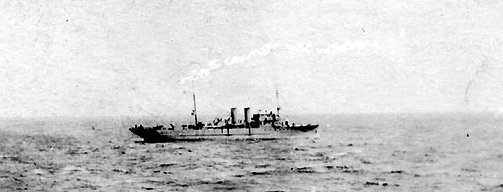
Isabel and her fellow yachts, Aphrodite (S. P. 135), Corsair (S. P. 159), and Noma, along with the French vessels Etourdi and Eveille departed Brest on 7 July 1918, and escorted a 28-ship convoy westward for 68 hours and 473 miles. Detaching from the westbound convoy, they rendezvoused with an eastbound convoy of 12 ships at 4:00 p.m. on the 10th. Later joined by Flusser and Preston at 5:00 a.m. on the 11th, they brought the majority into La Pallice, while Aphrodite and Corsair brought two into Le Verdon, France. Isabel then stood into Brest on 13 July. The yacht continued this operational tempo of convoy escort missions interspersed with time in port into August.
Convoy HB-8 was enroute eastbound into France, on 16 August 1918. Two German submarines, U-90 (Oberleutnant zur See Helmut Patzig) and U-107 (Kapitänleutnant Kurt Siewert), were then lurking in the convoy’s path. At 5:40 p.m. on the 16th, the cargo transport West Bridge's (Id. No. 2888) turbine broke down and could not be repaired. As the ship dropped back within the convoy, Lt. Cmdr. Mortimer Hawkins, USNRF, her commanding officer, notified the convoy commodore of his ship’s plight. Meanwhile, the convoy continued on its way, when shortly before 6:00 p.m., and four miles ahead of the now drifting West Bridge, U-90 torpedoed the U.S. merchantman Montanan. Noma closed with West Bridge and stood by the disabled freighter. Meanwhile, U-107 approached unseen and launched two torpedoes. One hit West Bridge forward, near her No. 3 hold and the other amidships abreast of the engine room. The stricken freighter immediately took on water and commenced to sink, initially listing to starboard. Hawkins ordered "abandon ship," and the crew took to the boats. Noma sped off in the direction from which the torpedoes had come and subjected the U-boat to a heavy depth charge barrage. Isabel was dispatched from Brest at 11:30 a.m., in company with the tug Concord (S. P. 773). They were joined by a French gunboat at 7:30 p.m. and continued to steam toward the crippled freighter. They arrived at the scene reported by the French aviso Aisne at 1:00 a.m. on the 17th, and searched for West Bridge. At 9:00 a.m., they fell in with Smith, the tug Barnegat (Id. No. 1232), and a French tug. These vessels formed a scouting line until Smith made contact with West Bridge which was under tow from the British tugs Epic and Woonda. Isabel put Concord and Barnegat in tow of the freighter, whose decks were now awash. Truxtun intercepted the vessels as they made their way into Brest at 11:00 a.m. on the 20th and assumed the SOP. All stood into Brest later that day.
Isabel spent the remainder of the war in her convoy escort and antisubmarine role. Two incidents of note occurred on 21-22 October 1918. Isabel was tasked with testing the Walzer Listening Device in conjunction with a French submarine in Douaruenez Bay on 21 October. When she submitted her report on the test, it was noted that the device was “very accurate and reliable”. The next day, at 10:30 a.m. while escorting a southbound coastal convoy, the officer of the deck noted a Navy hydroplane circling at low altitude and dropping a smoke bomb halfway between her and the head of the convoy. The ship went to general quarters and worked up to full speed. Upon reaching the site of the smoke bomb, she dropped two depth charges. Two French submarine chasers and two French trawlers that circled the area also joined. After the aircraft dropped another smoke bomb, Isabel again maneuvered to the site and dropped two more depth charges. She then stopped to listen with the Walzer device. Nothing was heard, but she continued to search the vicinity until 11:00 a.m. In moving to the head of the convoy she detected an oil slick and dropped two more depth charges. As in the previous efforts, there were no results from the detonations. She arrived at Ponta Delgada at 5:00 p.m. the next day. She returned to Brest from the Azores on the 24th and left later that same day bound for Plymouth, England (Base No. 27), arriving on 25 October. She steamed out of Plymouth the next morning and on 30 October received orders transferring her to Division One, Flotilla One, with Prometheus as her mother ship. She departed on 2 November from Quiberon Bay escorting Convoy OP-30 to Milford Haven, Wales. She left the convoy at 3:00 a.m. on 3 November and headed for Brest.
When the Armistice went into effect on 11 November 1918, Isabel was at sea. She stood into Brest with Benham and Preston on the 13th. With the war over, it was decided that a cross-channel service was to be established between Folkestone, England, and Boulogne, France. Isabel received orders on 28 November, that she was to be ready to commence cross-channel service from Folkestone on 30 November. She departed Brest on the 29th. She was subsequently relieved from this duty by Jarvis on 4 December. Isabel cleared Brest on 16 December, in company with Tucker (Destroyer No. 57), Drayton (Destroyer No. 23), Cummings (Destroyer No. 44), Burrows (Destroyer No. 29), and McDougal (Destroyer No. 54). Returning via the Azores and Bermuda, Isabel stood into Boston on 2 January 1919. Three days later, on 5 January, she received orders to proceed to the Philadelphia [Pa.] Navy Yard and once there, to await further instructions. Departing on 18 February, she touched at Newport, R.I. (18-19 February) and arrived at Philadelphia on 20 February. She received orders on 25 April detaching her from Flotilla A, Destroyer Force and directing her to proceed to the commanding officer of K-5 (Submarine No. 36) for temporary duty as a tender to the vessels going up the Mississippi River for recruiting and advertisement. Departing on 14 May, she arrived at Key West, Fla. on 17 May.
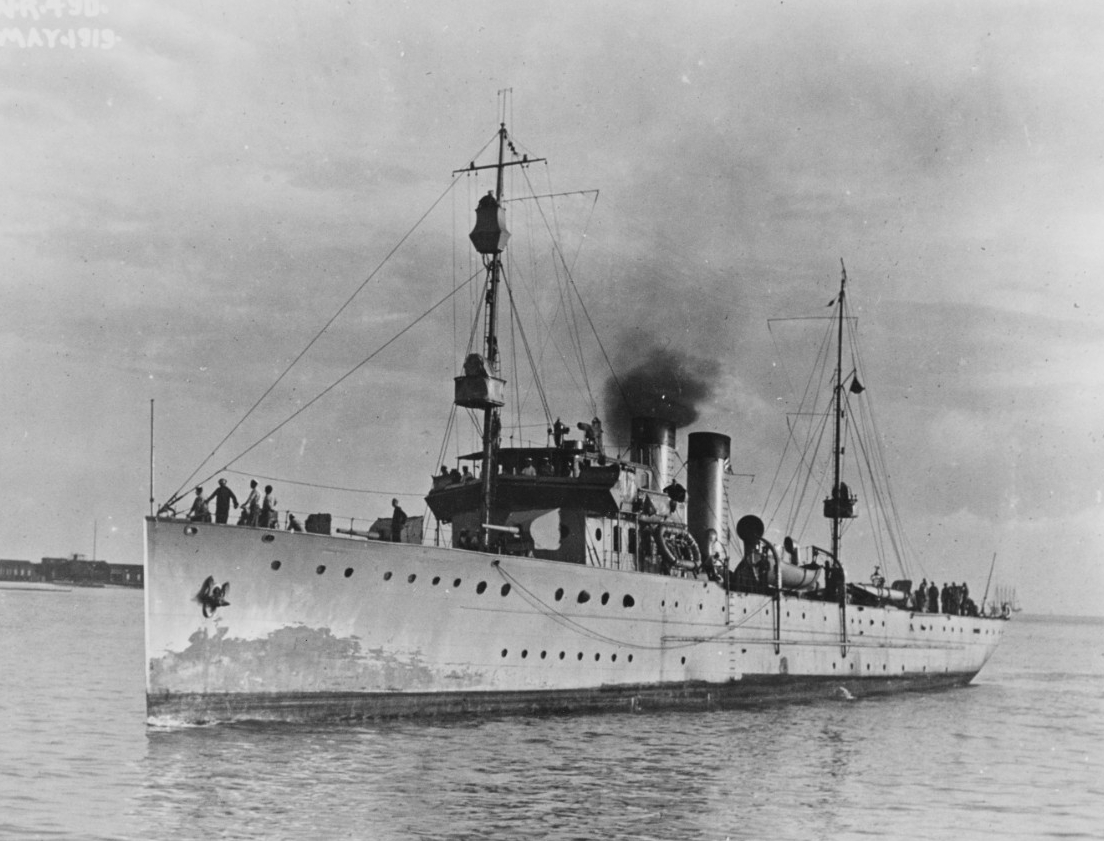
In company with the other ships on the tour, Isabel departed Key West on 19 May. Touching at Pensacola, Fla., on 21 May, they moved onto New Orleans, La. (22 May); Natchez, Miss. (30 May); St. Louis (13 June); Helena, Ark. (2 July); Vicksburg, Miss. (6 July); Natchez (11 July); Baton Rouge, La. (14 July); Plaquemine, La. (18 July); Donaldsville, La. (19 July); and entering the New Orleans Navy Yard on 1 August.
She remained until the 26th, when she got underway bound for Rockaway Beach, N.Y. En route she touched at Key West (27-29 August 1919) and then returned to the Philadelphia Navy Yard (31 August-17 September) before arriving at Rockaway Beach on the 18th for duty as a tender for the NC-4 Flotilla. Departing New York on 24 September, she moved to Portland, Maine (25-27 September); Boston, Mass. (27 September-1 October); Providence, R.I. (1-3 October); New Haven, Conn. (3-5 October), before returning to the Philadelphia Navy Yard on 6 October. Departing on 10 October, she moved to Baltimore, Md. (11-15 October); Washington, D.C. (15-16 October); Norfolk Navy Yard, Portsmouth, Va. (17-22 October); Charleston, S.C. (23-27 October); Jacksonville, Fla. (27-29 October); Miami, Fla. (30 October-1 November); Key West (1-2 November); Pensacola (3-4 November); New Orleans (5 November-15 December); Galveston, Texas (16 December-21 December). Isabel then returned via Pensacola to Rockaway Beach on 4 January 1920. Having subsequently returned to the Philadelphia Navy Yard, she was subsequently placed out of commission there on 30 April 1920.
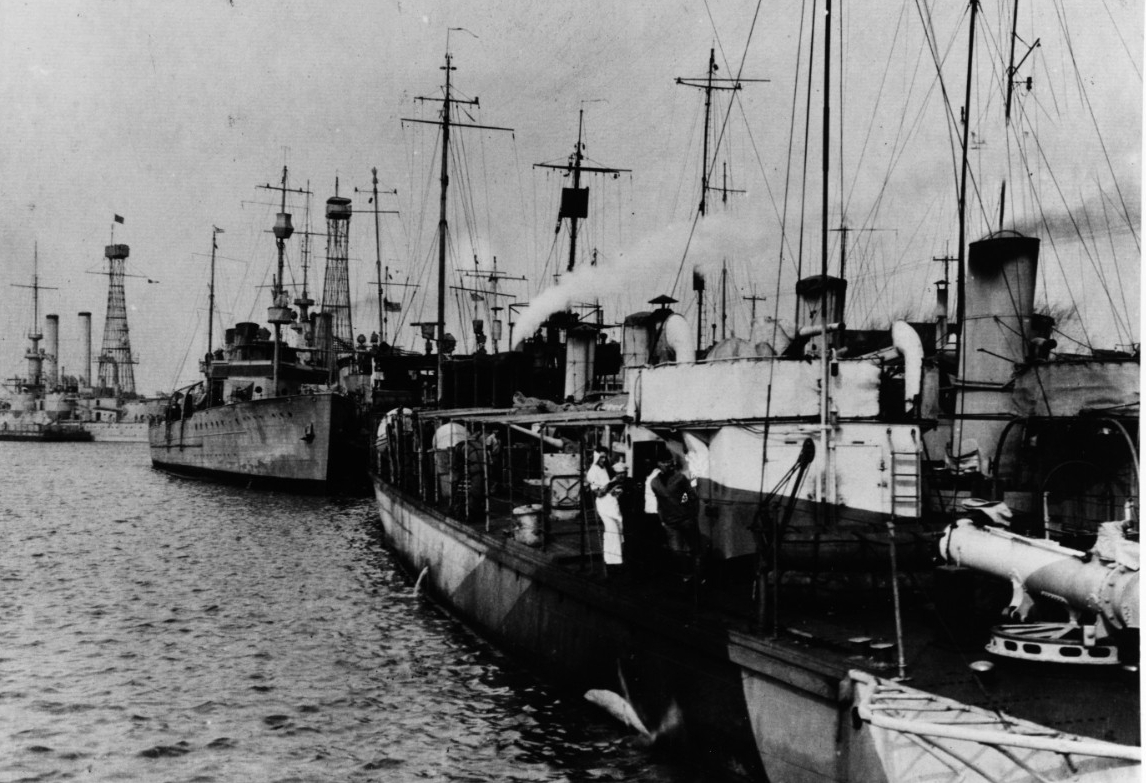
Re-designated PY-10 as part of a Navy-wide administrative change on 17 July 1920, Isabel was placed back into commission at the Philadelphia Navy Yard on 18 July 1921, Lt. Cmdr. Frank Loftin in command. Ordered to service in the Far East, Isabel cleared Philadelphia on 21 August 1921, en route to join the Yangtze Patrol. The converted yacht made her transit to Asia by crossing the Atlantic as opposed to passing through the Panama Canal and then heading across the Pacific. Enroute to Gibraltar, she touched at Bermuda (23-27 August) and Ponta Delgada (4-6 September), arriving on 9 September. Getting underway again on the 14th, she visited Port Said, Egypt (22-26 September), prior to transiting the Suez Canal en route to Aden, Yemen (3-7 October). From Aden, she moved on to Bombay [Mumbai], India (15-18 October); Colombo, Ceylon [Sri Lanka] (21-24 October); and Singapore (29 October), finally arriving at Hong Kong on 7 November.
Isabel, as flagship, and the other gunboats of the Navy’s Yangtze Patrol Force (YangPat) in China were charged with protecting American commerce from pirates and American nationals from the dangers of almost constant war between rival warlord factions. Isabel shifted from the British Crown colony to Shanghai, her primary base, on 12 November 1921. She then underwent modifications to make her fit to serve as the YangPat flagship. Rear Adm. William H. Bullard broke his flag on her on 19 January 1922 and she steamed up the Yangtze to Hankow [Hankou] where she arrived on 23 January. This was the initial movement of what would be Isabel’s typical pattern of deployment during her time with the YangPat, spending the low water season of autumn and winter on the river at Hankow and returning to the coast at Shanghai during the summer. As such, she remained at Hankow until June.
During this time the area upriver from Hankow was in a state of decided unrest. There were continual troop movements by the various warlord factions and sporadic firings upon foreign merchant vessels plying above Hankow. Departing on 11 June 1922, she shifted to Kiukiang [Jiujiang] (11-24 June), they steamed down river to Shanghai, arriving on the 25th. She operated in the vicinity of the Yangtze until 25 August when she began her return upriver to Hankow, stopping at Nanking [Nanjing] (26-28 August) and Kiukiang (29 August-1 September), before arriving at Hankow on 1 September. Getting underway again on 7 September, she “showed the flag” at Siachwan (7-8 September), Shaxi (8-9; 25-26 September), Ichang [Yichang] (9-25 September), Chenglin (26-27 September) before returning to Hankow. Getting underway again on 7 November she headed back to Shanghai, arriving on the 10th. She moved to Woosung [Wusung] and conducted her annual target practice (13-16 November). Clearing Shanghai on 20 November, she visited Chinkiang [Zhenjiang] (23-24 November), Wuhu (24-25 November), Anking (25-27 November), and raising Hankow on the 29th. Having moored, she would not return downriver in 1922.
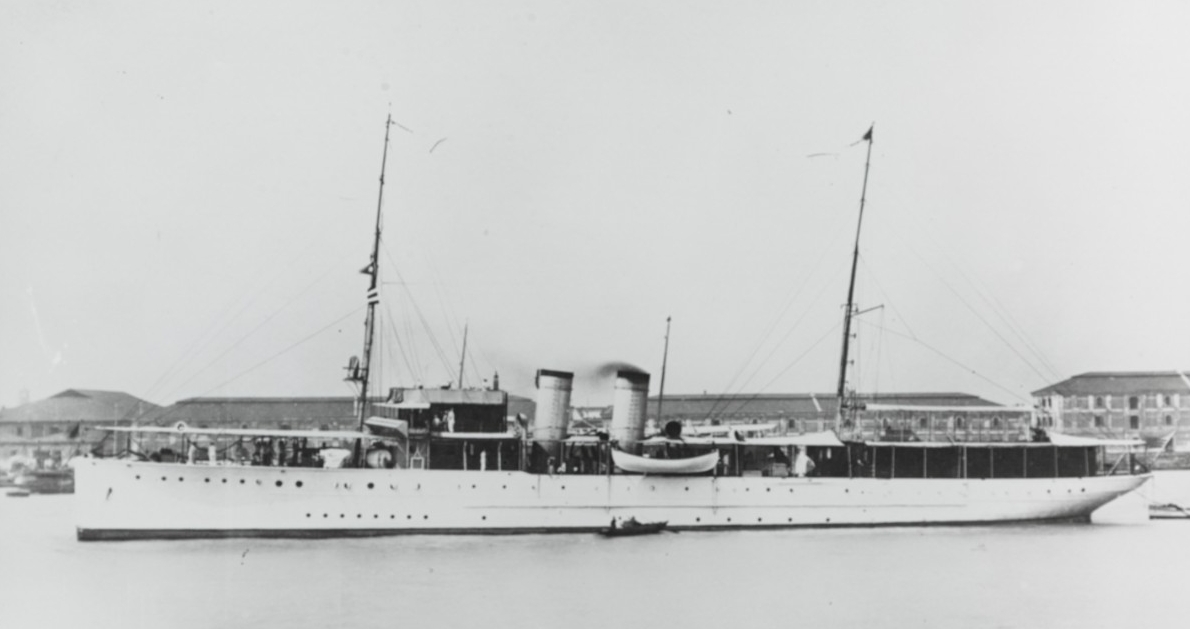
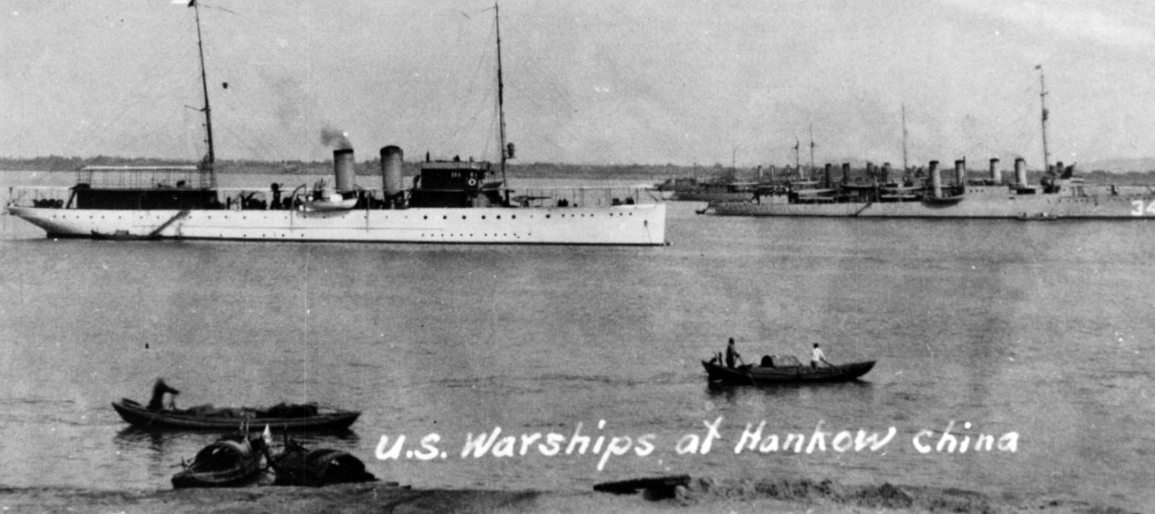
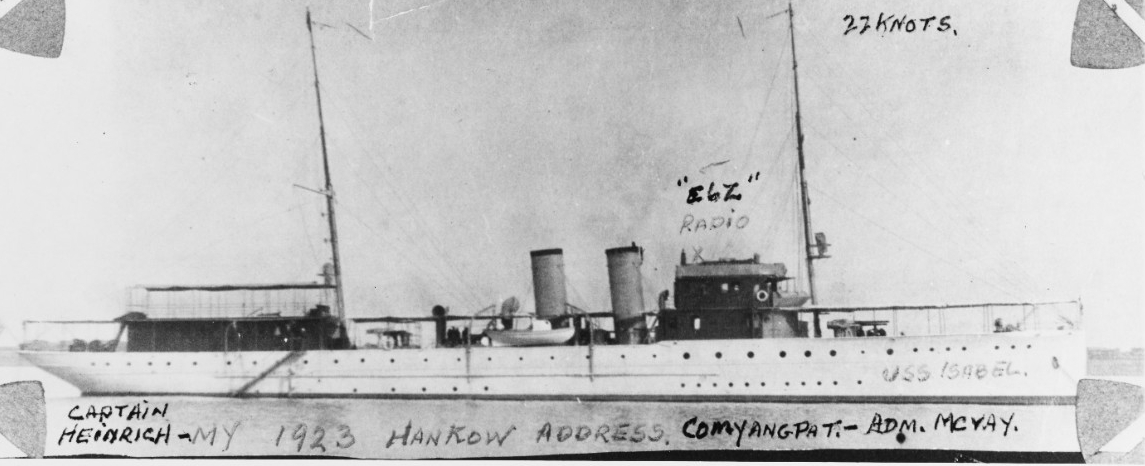
Isabel conducted some local movement in the Hankow area in March 1923, but she would not make her way downriver again until departing on 1 May for Nanking. Arriving on the 3rd, she stood overnight, then shifted to Shanghai the next day. Though she would return to Hankow (16-21 May), she spent would spend the next six weeks on the Lower Yangtze. This included conducting full power and endurance runs at Woosung on 25 May. She was to conduct her annual gunnery practice with Elcano (PG-38), but the presence of an excessive number of vessels in the designated training area precluded that practice.
Departing Shanghai on 1 June 1923, she made her way back upriver via Nanking (2-4 June), Anking (5-7 June), and Kiukiang (7-9 June), arriving on 10 June. The YangPat flagship then operated upriver for the next three months. Departing Hankow on 10 September, she arrived at Shanghai on the 12th. Staying for about a month, she returned up river and arrived at Hankow on 16 October. Isabel remained in the vicinity of Hankow through the new year and did not begin to head downriver until 6 May 1924. Deliberate in her movement toward Shanghai, she only arrived at Ichang on 24 June. After a stay of four days, she was underway again on 28 June bound for the mouth of the Yangtze. Arriving on 4 July, she remained until the 8th, then went to sea until the 11th, when she stood back into Shanghai. But for a short trip to Kiukiang (28-29 August), Isabel continued on the coast until 25 October. Steaming back up river, she arrived at Hankow on 28 October and remained there well into 1925.
Isabel raised steam and headed downriver toward Shanghai on 13 April 1925. With a stop at Nanking (14-16 April), she later arrived at Shanghai. Departing the next morning, 17 April, she headed back upriver via Foochow [Fuzhou] (18 April) and returned to Hankow on the 21st. After a visit to Ichang (16-19 May), the flagship steamed downriver on 3 June and raised Shanghai on the 6th. She remained on the Lower Yangtze into October, undergoing training and a maintenance period. Standing out on 19 October, she steamed upriver via Chinkiang (20-21 October) and Nanking (23 October) before mooring back at Hankow on 28 October.
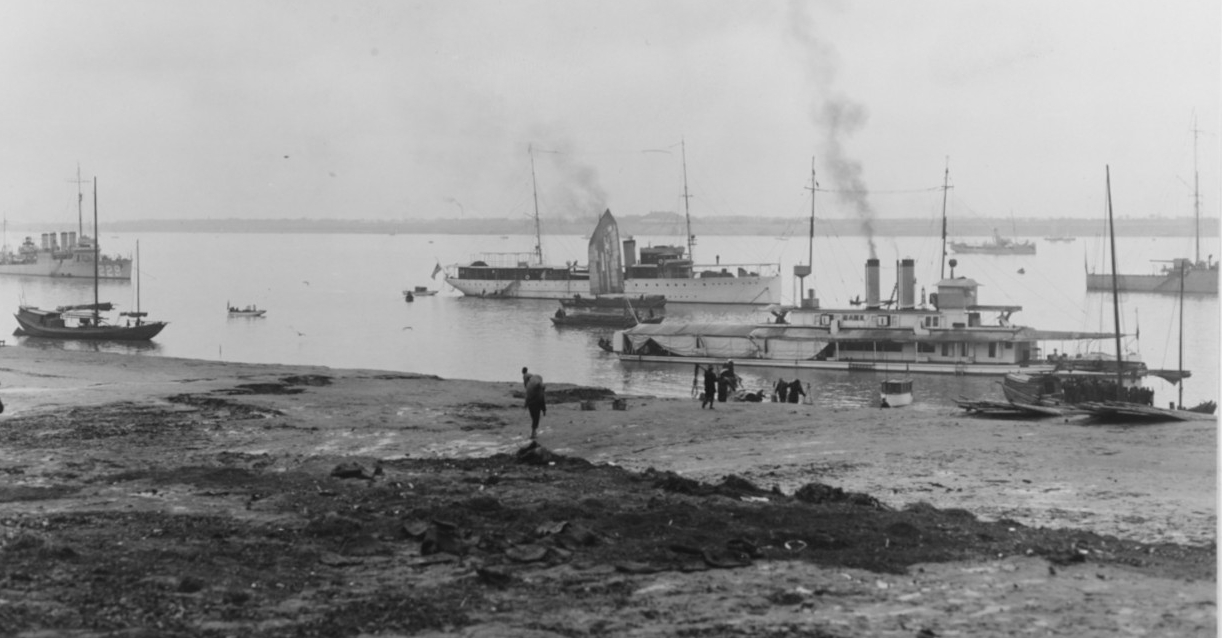
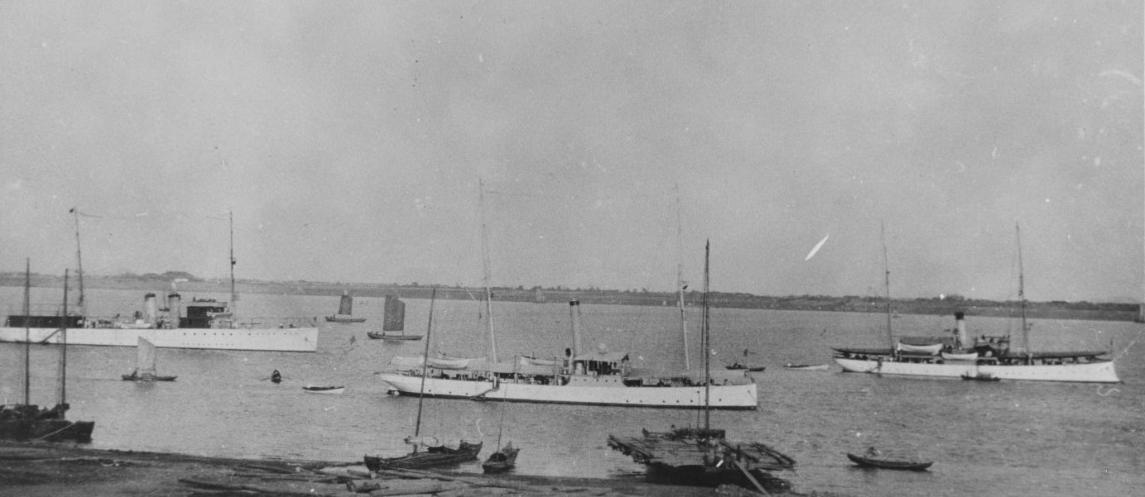
Isabel remained at Hankow into the spring of 1926. Getting underway on 8 April, she made her way downriver to Woosung (13-14 April) before standing into Shanghai. She cleared Shanghai on 6 May and returned via Woosung to Hankow on the 13th. Weighing anchor again on 16 May, she made visits along the Yangtze at Ichang (19-28 May) and Chenglin (28 May). From Chenglin she moved into Tungting [Dongting] Lake and up the Hsiang [Xiang] River to Changsha. After two days in Changsha (29-31 May), she headed back to Hankow, where she arrived on the 31st. She stood in port at Hankow for just over two weeks, when she departed on 15 June bound for Shanghai. Transiting via Kiukiang and Nanking, she arrived at Shanghai on 27 June. Though she would return to Hankow (20-26 July; 12-18 August), Changsha (26 July-2 August), and Ichang (4-11 August), she would spend most of the months to November 1926 in the Lower Yangtze. During this time, in October, Isabel came under fire as she became caught in a firefight between rival warlord armies while underway on the Yangtze. Clearing Shanghai on 1 November, she arrived back in Hankow on 7 November and resumed her typical winter quarters into the spring.
Isabel got underway on 23 March 1927 and stood out of Hankow bound for Nanking. That same day, with the rapidly approaching National Revolutionary Army (NRA) under Chiang Kai-shek [Jiang Jieshi] about to reach Nanking, Chang Tsung-ch'ang [Zhang Zongchang], the Beiyang faction warlord, gave orders for his defeated troops to withdraw from the city. Some of his soldiers who were unable to retreat in time, deserted, and began to loot foreign properties and attacked two foreigners who were in their way. In the early morning of 24 March, Chiang’s forces began to enter Nanking without any resistance from Chang’s army. Afterwards they entered the British, American, and Japanese consulates to search for suspected enemies hiding inside, but left peacefully after finding none. Immediately afterwards, however, uniformed soldiers and local Chinese residents started large-scale rioting against foreign interests, burning houses, and attacking the British, American and Japanese consulates, and killing Dr. John Elias Williams the American vice president of Nanking University. The NRA 6th Army, with its large contingent of communist soldiers, systematically looted the homes and businesses of the foreign residents, and killed one American, two Britons, one French citizen, an Italian, and a Japanese. Chinese snipers also targeted the American consul and U.S. Marines who were guarding him.
In response, the Royal Navy immediately sent the heavy cruiser HMS Vindictive, the light cruisers HMS Carlisle, Caradoc, and Emerald, the minesweeper HMS Petersfield, the gunboat Gnat and the destroyers HMS Witherington, Wolsey, Wishart, Veteran, Verity and Wild Swan toward Nanking. Gnat’s sister ship HMS Aphis arrived toward the end of the engagement, and HMS Cricket was also involved in the naval operations at the time. Five U.S. destroyers were also dispatched to engage the NRA; these included Noa (DD-343), William B. Preston (DD-344), John D. Ford (DD-228), Pillsbury (DD-227) and Simpson (DD-221). At 3:38 pm, high explosive rounds and machine gun fire from Emerald, Wolsey, Noa, William B. Preston and the Italian gunboat Ermanno Carlotto (other warships may have participated in the bombardment as well) drove off the NRA soldiers and Chinese rioters. After the shelling, sailors from Noa and William B. Preston then rescued foreign civilians hiding on Socony Hill. The two U.S. vessels fired 67 shells by this point and thousands of rifle and machine gun rounds. Isabel arrived at Nanking amidst this action.
By midnight, Nanking was burning and littered with bomb craters and casualties from the battle. Early the next morning, just before dawn, William B. Preston was weighing anchor to escort the merchantman Kungwo out of the area. She was filled with evacuees and needed protection, but just as the two ships were starting to leave, sniper fire from the riverbanks hit William B. Preston and the Americans returned fire with their Lewis guns and soon silenced the attackers. Three hours later, as the two vessels steamed down the river, William B. Preston was attacked again. This time, the two ships were in between Silver Island and Fort Hsing-Shan. Rifle fire was first heard, and William B. Preston′s crew was preparing their machine gun when 3-inch guns at the fort suddenly engaged them. Several shots missed the ships, but one eventually hit William B. Preston′s fire control platform. After turning Kungwo over to the British, William B. Preston returned to Nanking and later joined HMS Cricket and SS Wen-chow, 52 mi (84 km) south of Chinkiang. Snipers once again harassed the ships, but machine gun fire from Cricket quickly forced the Chinese to retreat. A 4-inch gun was then aimed at the fort, and after a few rounds the Chinese guns were silenced. Later, the Japanese sent the gunboats Hodero, Katata, Momo, and Shinoki. The French also sent the aviso La Marne for the evacuation of their citizens. By March 26, NRA commander Cheng Qian restored order in Nanking and successfully restrained soldiers from further hostile actions against foreign forces, while requesting the Red Cross to mediate a cease fire with foreign naval vessels. On March 27, with 70 more refugees aboard, William B. Preston left Nanking and headed downriver. Lt. Cmdr. George B. Ashe later recalled that the Chinese had emplaced a field-piece at a river bend outside of Nanking, so he ordered general quarters well in advance of the battery, but the Chinese did not open fire. By the end of that day all hostilities ended. About 40 people were killed in total. Isabel remained in the area until 31 March and then headed downriver. Arriving at Kiukiang from Wuhu on 3 April, she left that same day and steamed toward Hankow as news arrived that the NRA had captured Hankow. American and British residents had been advised to evacuate the city and on that same day Standard Oil decided to close up operations in Ichang and withdrew all its U.S. employees on American and British ships. As the NRA units advanced into Hankow, they invaded the Japanese concession, looting and attacking Japanese residents and consular staff. A number of servicemen of the Imperial Japanese Navy were injured and 150 homes were damaged.
Around 4:00 p.m. a crowd of several thousand Chinese flying the red banners and tried to descend on the riverfront, a Japanese naval landing force came ashore. The rioters retreated but plundered as they left the concession. The Japanese landing party fired warning shots with their machine guns and the crowd fled and attacked Japanese businesses located in the concessions of other countries. That night, 25 Japanese escaped to the British gunboat HMS Bee and were protected. General Tang Sheng-chih [Tang Shengzhi], the garrison commander at Wuhan, dispatched his army on the morning of 4 April and took charge of the city. The Japanese deployed the 18th Destroyer Group, consisting of Amatsukaze, Isokaze, and Tokitsukaze, were also deployed. With the unrest in the city, Isabel remained at Hankow into June. Getting underway on 28 June, she steamed downriver and stood into Shanghai on 30 June.
It was noted in the Annual Report for the U.S. Asiatic Fleet, 1 July 1926-30 June 1927 [dated 25 July 1927] that “Every vessel attached to the Yangtze Patrol is distinctly unfit for the duty expected of it. …Isabel has too large a draft, too small a rudder, and is dangerous to operate above Chenglin.” The report also noted that, “Not a vessel of the Yangtze Patrol Force was able to hold any form of target practice during the year. Most of them, however, were under fire at some time during the year by rifles and machine guns, and several were compelled to use their main batteries to repel attacks made upon them from the banks of the river.” Despite her inadequacies for the accomplishing the mission for which she was charged, Isabel continued to perform her mission on the river showing the flag and protecting American interests.

Isabel steamed back up the Yangtze on 18 July 1927 and arrived at Hankow on the 20th. She remained there for just over a month and headed back downriver on 22 August. The flagship remained on the lower Yangtze until 24 October. Arriving at Hankow on the 27th, the patrol ship remained until 14 November before returning downriver to Shanghai via Kiukiang (15-16 November), Wuhu (16-18 November), Chinkiang (18-20 November) and arriving on the 20th. She remained at Shanghai into January 1928. During this time, on 5 December 1927, Rear Adm. Yates Stirling Jr. broke his flag as Commander, Yangtze Patrol Force on board the ship.
Isabel spent the early part of 1928 on the lower Yangtze. On 1 May, she raised steam and headed upriver back to Hankow, arriving on 6 May. Remaining at Hankow until 27 May, she headed back downriver to Shanghai via Kiukiang (27-29 May) and stood into Shanghai on the 31st. The warship would remain in the waters around Shanghai until heading back upriver on 29 July and arriving at Hankow on 2 August. She visited Chenglin (22-28 August) and returned to Hankow before heading back downriver on 1 September. Stopping at Kiukiang (1-2 September) and Wuhu (3 September), Isabel reached Shanghai on the 5th. After two months at Shanghai, she stood out on 6 November and steamed upriver to Hankow. Remaining from 11 November to 26 November, she then got underway to return to Shanghai. Making multiple stops along the Yangtze enroute, she finally arrived at Shanghai on 19 December. She would spend the remainder of the year there and would not get underway again until May 1929. During this time at Shanghai, on 12 February 1929, Isabel was detached from the Yangtze Patrol and her service as flagship with that force and placed under the direct control of the Commander-in-Chief, Asiatic Fleet (CinCAF).
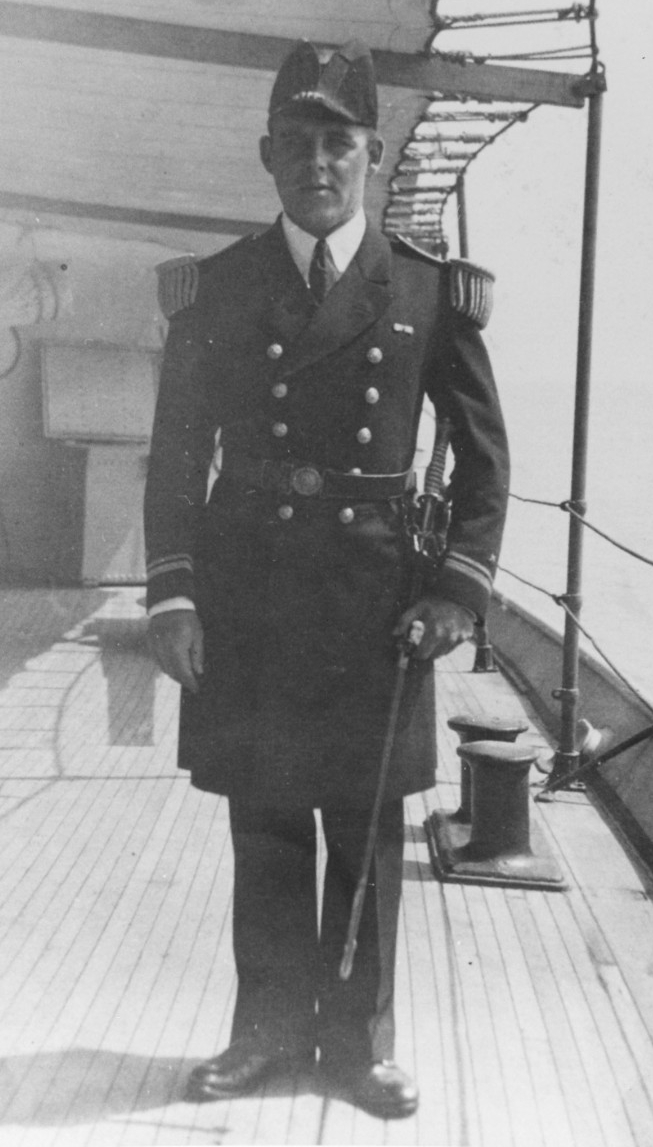
Isabel got underway again on 28 May 1929; steaming upriver, she was bound for Nanking. Stopping in the river overnight while enroute, she arrived the next day. She remained until 4 June, when she got underway to return to Shanghai, which she did on 5 June. She remained there through the end of the year and did not get underway again until 30 January 1930. Clearing Shanghai, she steamed across the South China Sea toward Manila, Philippine Islands and arrived on 3 February. Departing the next day for Marieles Bay, Philippines, she arrived on the 5th. Over the next nine days, she shuttled between there and Manila. Having arrived back at Manila on 14 February, she remained there into March. Departing on 10 March, she stood into Shanghai on the 14th. Isabel continued at Shanghai until heading upriver to Nanking on 17 May and returning after three days. Getting underway again on 4 June, she steamed to Tsingtao [Qingdao], China. Arriving on 5 June, she remained in the waters off the Shantung [Shandong] Peninsula until 29 June, when she steamed to Shanghai, arriving the next day. Isabel was underway again the following day, 1 July steaming toward the Shantung Peninsula. She spent the following months into the fall in these waters visiting Chefoo [Yantai] (2-4 July; 11-20 August; 20-21 September) and Tsingtao (4 July-10 August; 21 August-6 September; 21 September-13 October.), and Taku Bar [Tianjin] (8-20 September). Clearing Tsingtao on 13 October, she returned that same day to Shanghai. Isabel remained there until 30 November, when she went to sea. Arriving at Manila on 5 December, she would remain in port there well into the next year.
Isabel raised steam and got underway again on 22 March 1931, standing out of Manila, she steamed to Hong Kong and arrived on 25 March. After a five-day visit, she moved on to Amoy [Xiamen] (30 March-2 April) and Woosung [Wusong], China (4-5 April) before returning to Shanghai on the 5th. She remained in port until 5 June when she shifted to Tsingtao, arriving later that same day. After a week, she shifted to Chefoo (13-19 July) before returning to Tsingtao on the 20th. Remaining for a month, she got underway on 20 August and steamed to Shanghai, arriving the next day. Isabel next got underway on 20 September and steamed up the Yangtze to Hankow (23-25 September) before standing in to Shanghai on 27 September. The patrol vessel remained until 16 November, when she raised steam and cleared the mouth of the Yangtze. During her movements she visited Matsu [Mazu] Roads (17 November) and Amoy (18-19 November). At Amoy, Adm. Montgomery M. Taylor, CinCAF, transferred his flag to Isabel before moving on to Swatow [Zhangzhou] (20-23 November), and Hong Kong (24-29 November) before steaming to the Philippines and arriving at Manila on 1 December. Upon arriving back at Manila, CinCAF transferred back to the Asiatic Fleet flagship, Houston (CA-30). Adm. Taylor again transferred to Isabel at Olongapo, Philippines, on 16 December. then proceeded to Manila, arriving later the same day and remaining there until 21 January 1932, at which point Isabel returned to Olongapo (21-22 January), where CinCAF broke his flag again in Houston, returning to Manila on 22 January.
Having remained in area of Luzon, Philippines, into the new year, Isabel cleared Sangley Point, Philippines, on 2 February 1932 and returned to China, standing into Shanghai on 6 February. She stood in port until 25 February and shuttled back to Manila Bay, arriving on 28 February. The patrol vessel remained in the Philippines for two months, steaming out of Olongapo on 30 April and returning to Shanghai on 3 May. After almost five weeks, she left Shanghai on 7 June and reached Tsingtao the next day. Isabel then shifted to Chefoo on 9 August to embark Adm. Taylor, who transferred his flag to Isabel then proceeded to Hsinho, thence by train to Peiping [Beijing]. Meanwhile, Isabel remained at Chefoo until 17 August when she moved on to Hsinho, arriving the next day. She departed on 30 August, shifting to Taku Bar that same day. There the admiral broke his flag in Houston again on 1 September. The next day Isabel moved to Tsingtao via Chefoo and remained in port until the 19th. Getting underway that same day, she reached Shanghai the next day. She steamed out of Shanghai on 24 September and heading up the Yangtze arrived at Hankow on 27 September. Getting underway on 1 October, she steamed to Ichang (3-5 October).
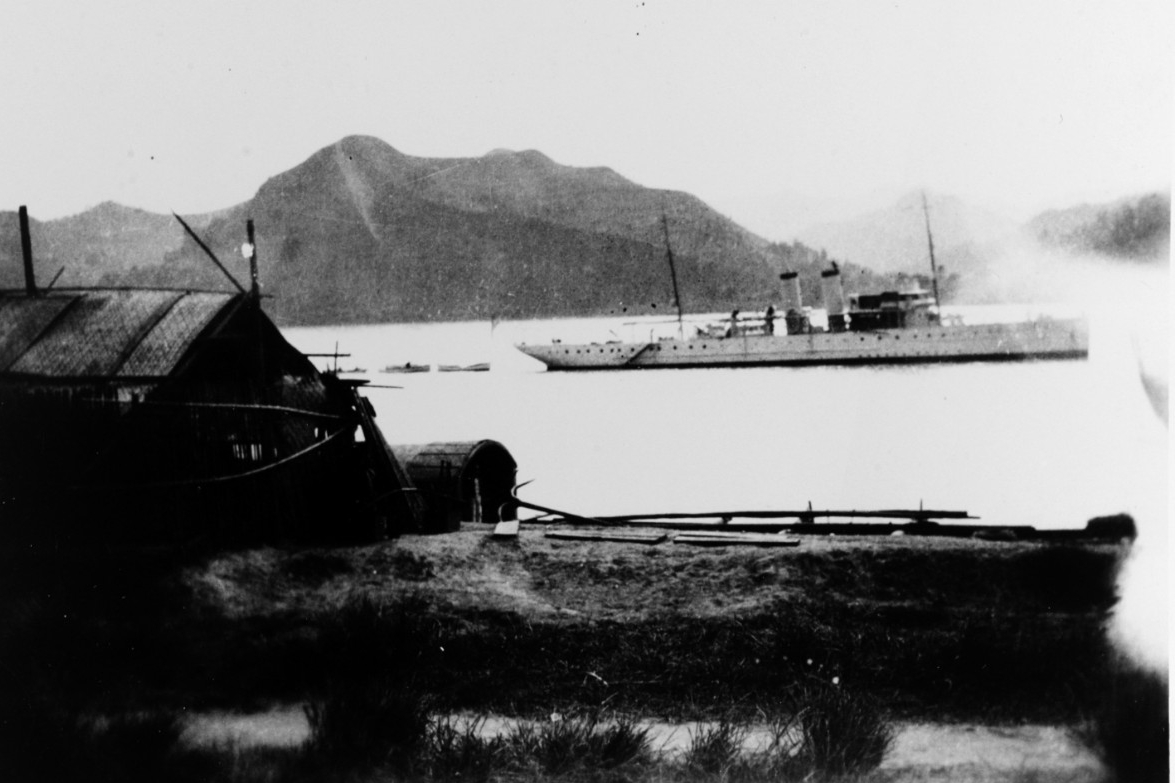
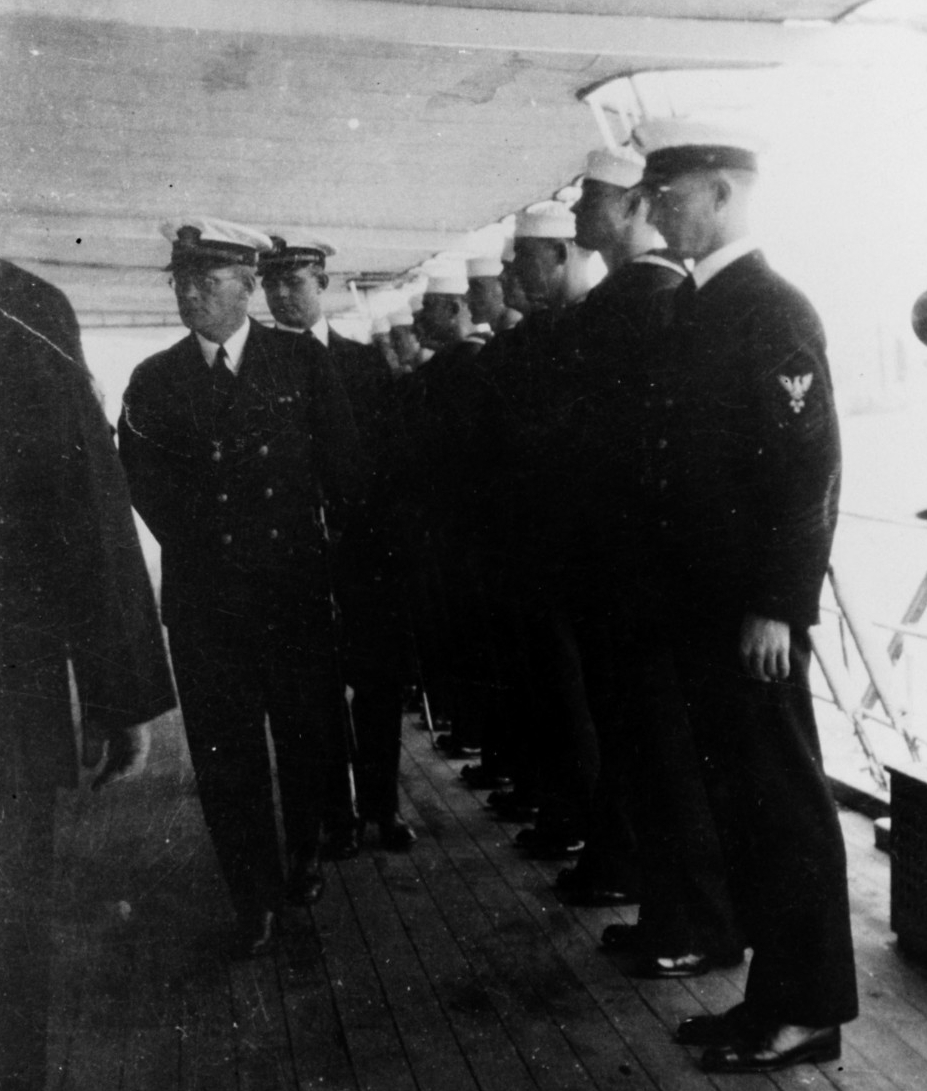
While at Ichang, Adm. Taylor again embarked on the vessel on 5 October 1932. She departed that same day and stood into Hankow the next. There Adm. Taylor disembarked and rejoined Houston at Hankow on 6 October. She steamed back down the river on 8 October and arrived back at Shanghai on the 10th. Remaining a month, she departed on 10 November. Bound for a rendezvous with Houston at Hong Kong, she reached the next day. While at Hong Kong, CinCAF transferred his flag to Isabel and visited Canton (22-23 November), then rejoining the cruiser at Hong Kong (23 November). The admiral then traveled in Isabel to Manila, where he remained from 28 November 1932 to 9 January 1933, then to Olongapo (9-10 January), where he rejoined Houston.
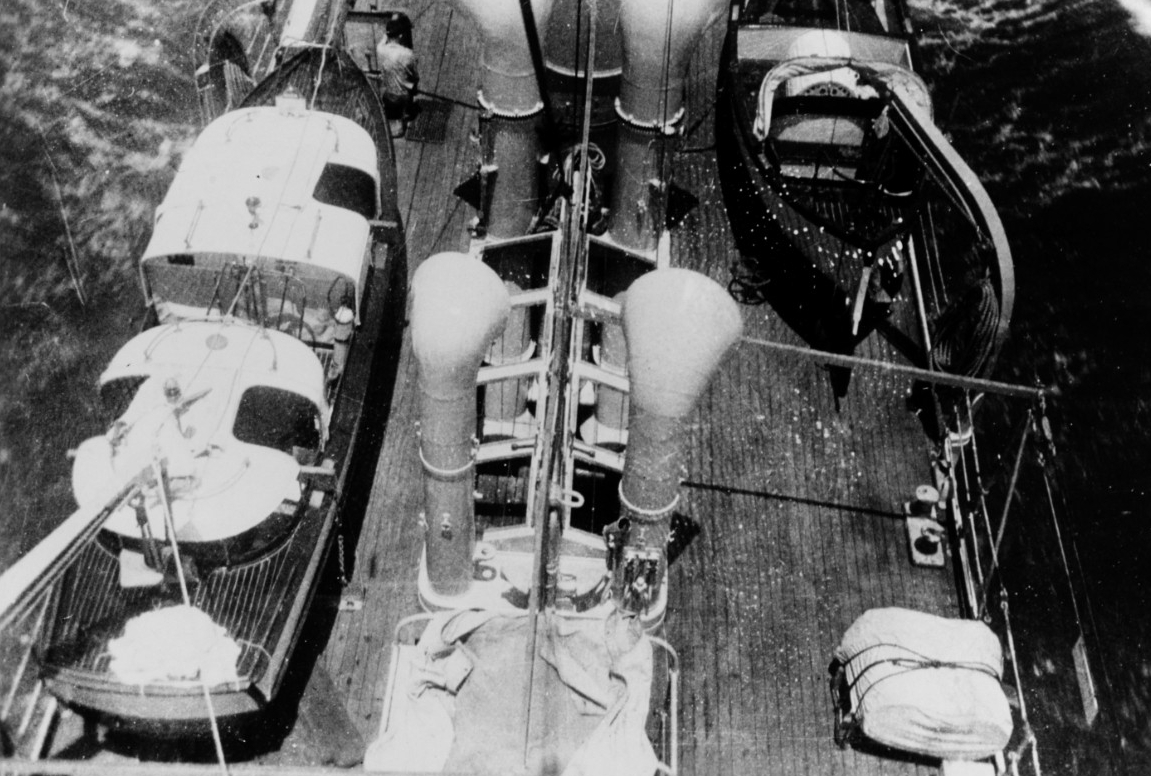
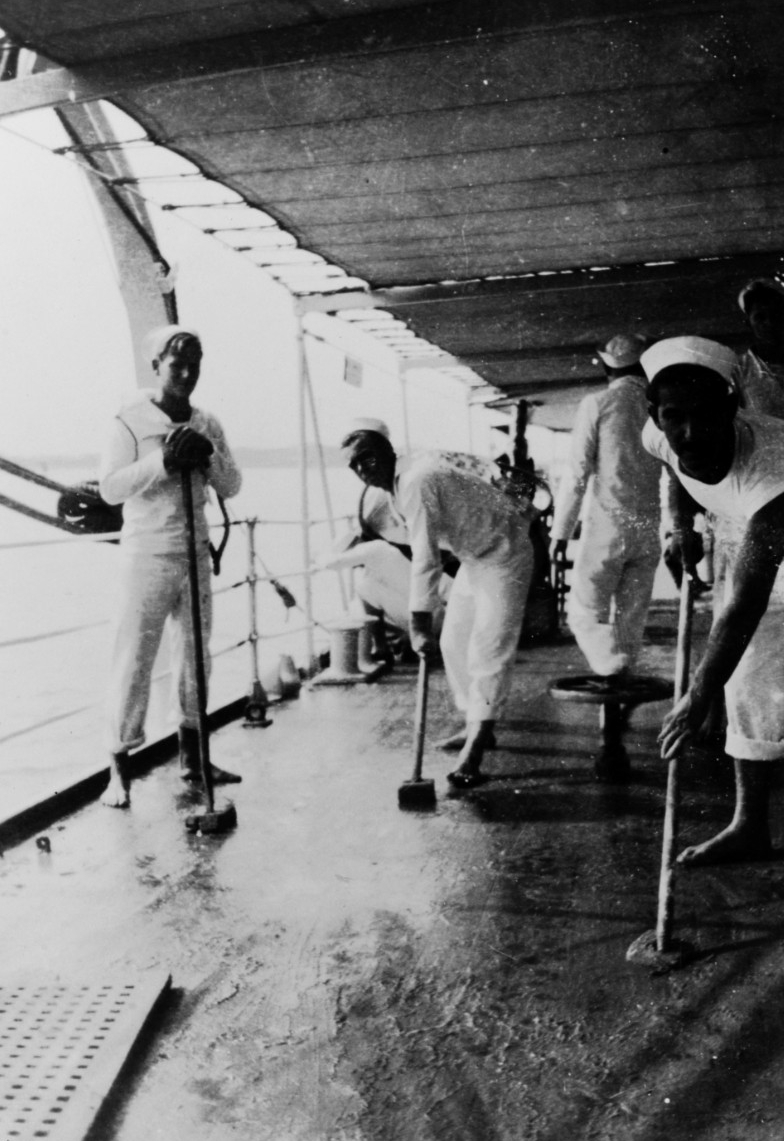
Isabel cleared Manila on 22 March 1933 bound for Shanghai, reaching on the 25th. She remained in port until departing for Hong Kong on 24 April. The patrol vessel stood into the British colony on 27 April and remained there until 3 May, when she got underway bound for Swatow. She visited Swatow (4-7 May), Amoy (8-11 May), and Pagoda Anchorage (12-15 May), before returning to Hong Kong on 16 May. Just over two weeks later, on 31 May, she shifted to Canton [Guangzhou] (31 May-22 June), then returned on the 22nd. She cleared Hong Kong on 1 July and reached Manila the 3rd. She spent the next two months in the Philippines, during this time, on 18 August, Adm. Frank B. Upham relieved Adm. Taylor as CinCAF. Isabel cleared Manila on 4 September and steamed to Chefoo (9-14 September) where Adm. Upham transferred his flag to Isabel, and then to Hsinho (14-21 September). On 15 September, Adm. Upham disembarked to travel to Peiping by rail. He returned to Isabel at Hsinho on 21 September, and thence to Houston. Returning to Isabel, Upham proceeded up the Yangtze to Nanking (25-28 September), and Hankow (30 September-6 October). Putting in to Shanghai on 8 October, he returned to Houston that day. Afterward, Isabel spent six weeks at Shanghai, before getting underway on 18 November in order to conduct port visits to Amoy (20-21 November), Swatow (23-24 November), Canton (24-25 November), and Hong Kong (26 November -1 December). She cleared Hong Kong on 1 December, and stood into Manila on the 4th, where she remained well into the next year.
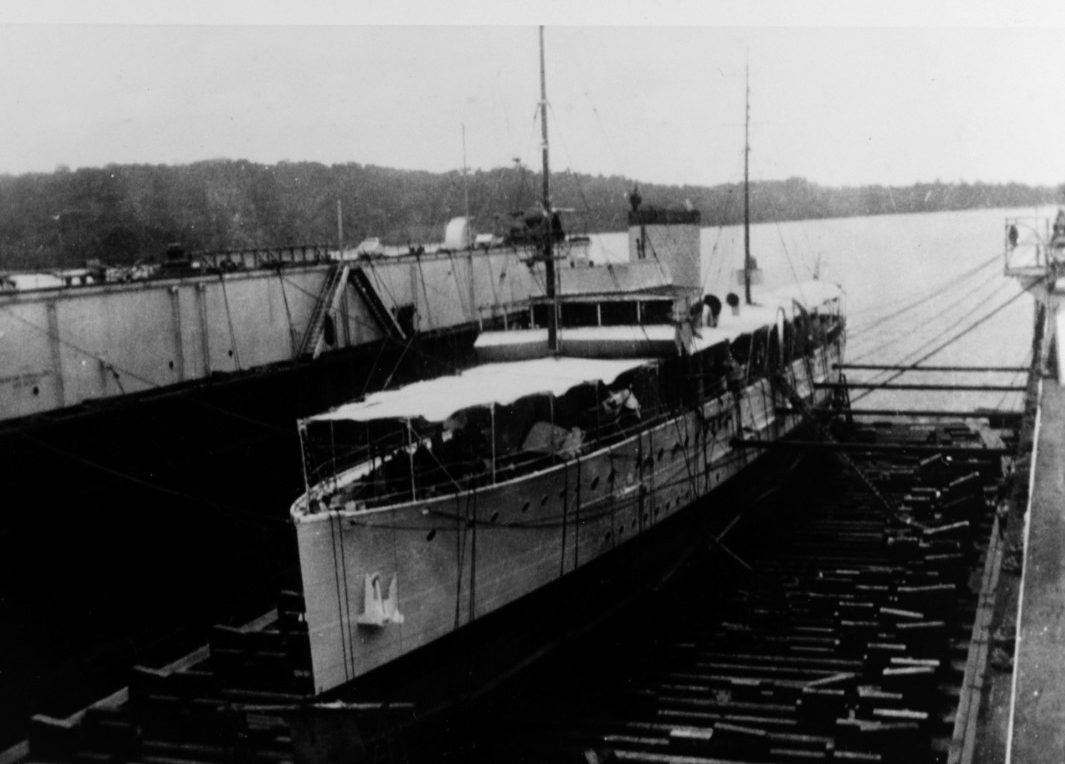
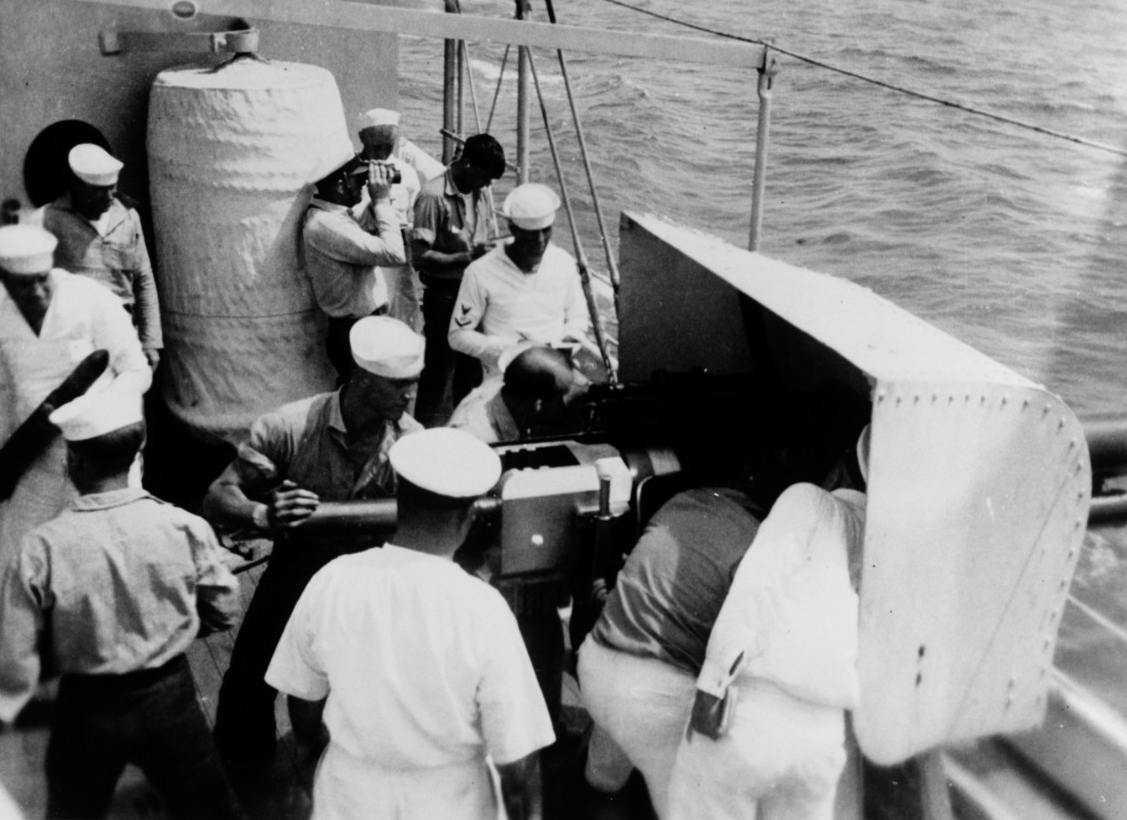
After almost six months in the Philippines, Isabel got underway bound for a return to China on 1 May 1934. She stood into Shanghai on 6 May and several days later, on the 10th, she was again underway, this time heading up the Yangtze. She arrived at Ichang on 16 May. Remaining until 24 May, she then moved on to Hankow, where she arrived on the 26th. Isabel then steamed back down the river on the 30th. Touching at Nanking on 1 June, she reached Shanghai the next day. Underway again on 11 June, she arrived the next day at Tsingtao. The yacht got underway on 14 July, bound for Chefoo. Arriving the next day, she remained until the 28th. Arriving back at Tsingtao on 29 July, she got underway again on 10 August. She spent most of the remainder of the year cruising Chinese waters and calling at various port cities multiple times including Amoy (16-20 August; 17-24 September; 9-21 November), Swatow (20-22 August; 8-23 October; 2-8 November), Hong Kong (23 August-6 September; 29 September-5 October; 25 October 4 November; 22 November-13 December). Shifting to Canton on 13 December, she spent the Christmas and New Years’ holidays there. Getting underway again on 2 January 1935 she continued to cruise the China coast with visits of varying duration to Hong Kong, Amoy, Swatow, and Canton. On 4 March, Isabel visited the Portuguese colony of Macao [Macau], where she remained until 8 March. On 17 March, at Hong Kong, Adm. Upham embarked on board Isabel (PY-10) for a trip to Canton (17-20 March) as his flagship Augusta’s (CA-31) draft did not permit her to make the passage up the Pearl River to Canton. Returning to Hong Kong, Adm. Upham disembarked and Isabel continued to cruise the Chinese coast visiting Canton (3-12 April) and Hong Kong (12-18 April). Departing the British crown colony, she reached Manila on the 20th. Remaining for over two months, she was underway again on 24 June for a return to Hong Kong and reaching on the 26th. Leaving that same day, she went to sea and then stood into Tsingtao on 30 June, where she remained into autumn.
![Isabel off Tsingtao [Qingdao], circa the mid-1930s. (Naval History and Heritage Command Photograph NH 101687) Isabel off Tsingtao [Qingdao], circa the mid-1930s. (Naval History and Heritage Command Photograph NH 101687)](/content/history/nhhc/research/histories/ship-histories/danfs/i/isabel/_jcr_content/body/media_asset_198749299/image.img.jpg/1502395432856.jpg)
Isabel resumed operations underway on 30 September 1935. Clearing Tsingtao, she steamed to Shanghai and reached her destination on 2 October. Adm. Orin G. Murfin relieved Adm. Upham as CinCAF on 5 October 1935. Adm. Murfin transferred to Isabel, and via Hong Kong (7-10 October), visited Bangkok, Thailand (15-22 October). Later, he returned to Augusta on 22 October to visit Singapore (24-30 October). Meanwhile, Isabel returned to Hong Kong (27-30 October; 31 October-2 November) and Canton (30-31 October) before making her way to Manila, where she arrived on 4 November. Back in the Philippines, she remained in Manila, into the following spring. During this time, Adm. Murfin flew his flag in Isabel from 14 December 1935 to 27 February 1936, while Augusta underwent her annual overhaul at Cavite and Olongapo.
Steaming out of Manila Bay on 30 March 1936, Isabel stood into Hong Kong on 1 April. Adm. Murfin, on 6 April, embarked in Isabel for the trip up the Pearl River to Canton (6-8 April), returning on the latter date to re-embark in his flagship to resume his voyage up the China coast. The yacht departed Hong Kong on 10 April. Moving to Shanghai (13-15 April) and Woosung (15-16 April), she continued up the Yangtze to Nanking (17-22 April) and Hankow (24 April-2 May), before steaming back down the Great River to Kiukiang (2 May) and standing into Shanghai on the 4th. There she remained until 1 June, getting underway bound for Tsingtao and arriving the next day. Isabel remained at Tsingtao through the summer. Getting underway on 30 September, she visited Shanghai (1-26 October), Amoy (28-30 October), and Hong Kong (31 October-12 November). From Hong Kong, she steamed back to the Philippines, where she entered the Cavite Navy Yard on 14 November.
Adm. Harry E. Yarnell, who had relieved Adm. Murfin as CinCAF in October at Shanghai, transferred his flag to Isabel on 2 January 1937, when Augusta entered Cavite Navy Yard for her yearly overhaul. The CinCAF used Isabel as his flagship through March, rejoining Augusta at Manila on 29 March 1937. Getting underway with Adm. Yarnell embarked on 27 January, Isabel made visits throughout the Philippines including Malampaya Sound (28-29 January), Bacuit Bay (29-30 January), Coron Bay (30-31 January), Manila (31 January-16 February), Jolo (18-19 February), Zamboanga (19-20 February), Cebu (20-23 February), Sorsogon (24-25 February), and Corregidor (26 February), before returning to Manila on the latter date. Isabel stood out of Manila on 6 April and reached Hong Kong on the 8th. Having embarked Adm. Yarnell, she made a trip to Canton (9-13 April). With the return to Hong Kong on 13 April, Adm. Yarnell returned to Augusta and the heavy cruiser and the yacht sailed for Swatow on the 18th, followed by Amoy the following day. The CinCAF shifted his flag again to Isabel on 20 April for a brief trip to Pagoda Anchorage at Foochow (21-22 April), rejoining the heavy cruiser on the 23rd. Augusta and Isabel stood up the Whangpoo [Huangpu] River on 24 April and arrived at Shanghai that day, mooring just upstream from the city proper. They remained at Shanghai until 5 May, when both sailed for Nanking. The flagship and her escort remained at that Yangtze port from 6 to 9 May before getting underway on the latter day for Kiukiang, further up the Yangtze. Shifting his flag to Isabel, Adm. Yarnell then visited Hankow and Ichang in that ship, transferring thence on 22 May to Panay at Ichang for the voyage up the Yangtze through the gorges and rapids that lay above that port.
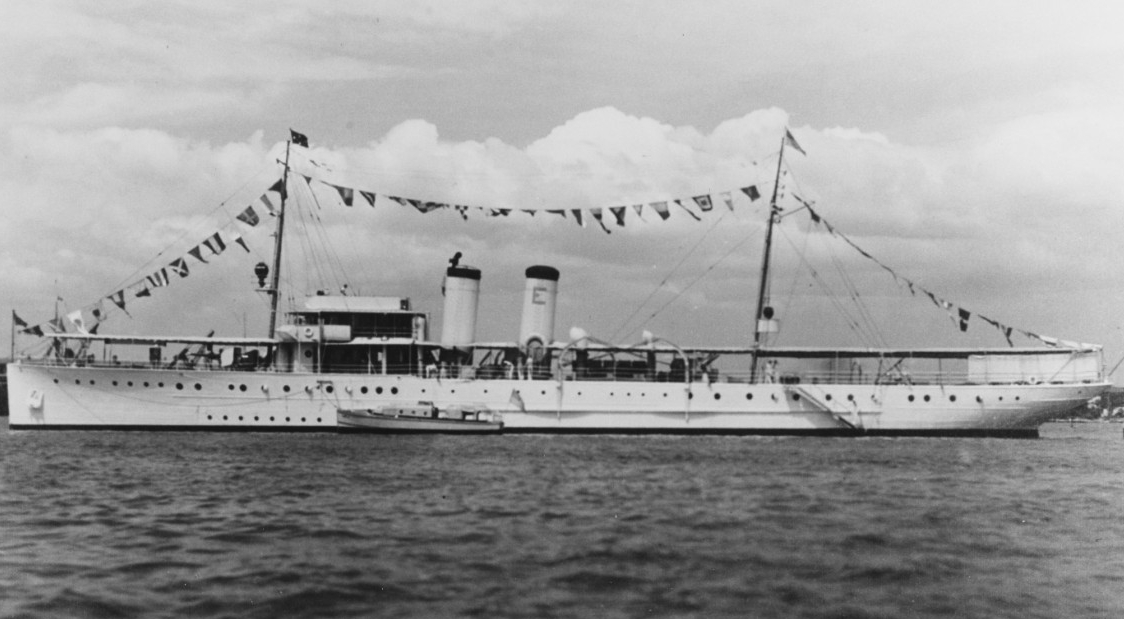
After visiting Chungking, the CinCAF returned to Ichang in Guam (PR-3), where he rejoined Isabel for the trip to Hankow and Nanking. Adm. Yarnell eventually rejoined Augusta at Shanghai on 2 June. Isabel remained until 22 June at Shanghai, then shifted to Tsingtao, where she reached the next day. The warship stood there through July and into August, departing on the 16th. Bound for Shanghai, she reached two days later. Over the next six weeks she visited several Chinese ports, Shanghai (18 August-1 September), Chefoo (3-4 September), and Tsingtao (5-8 September). Returning to Shanghai on 9 September, she remained in port for over a month. Clearing on 29 October, she steamed for Manila and arrived on 1 November. At Cavite until 14 December, she proceeded to cruise the Philippine archipelago visiting ports throughout the next nine days. She arrived back at Manila on 23 December and having spent Christmas in port there, she departed on New Year’s Eve bound for Shanghai.
Isabel stood into Shanghai on 5 January 1938. The next day, Augusta departed Shanghai for the Philippines, for her yearly overhaul period. Adm. Yarnell, however, his presence in China deemed necessary to uphold American prestige in China, remained in Shanghai with a token staff on board Isabel. He ultimately rejoined Augusta when she returned to Shanghai on 9 April 1938, after her yearly overhaul.
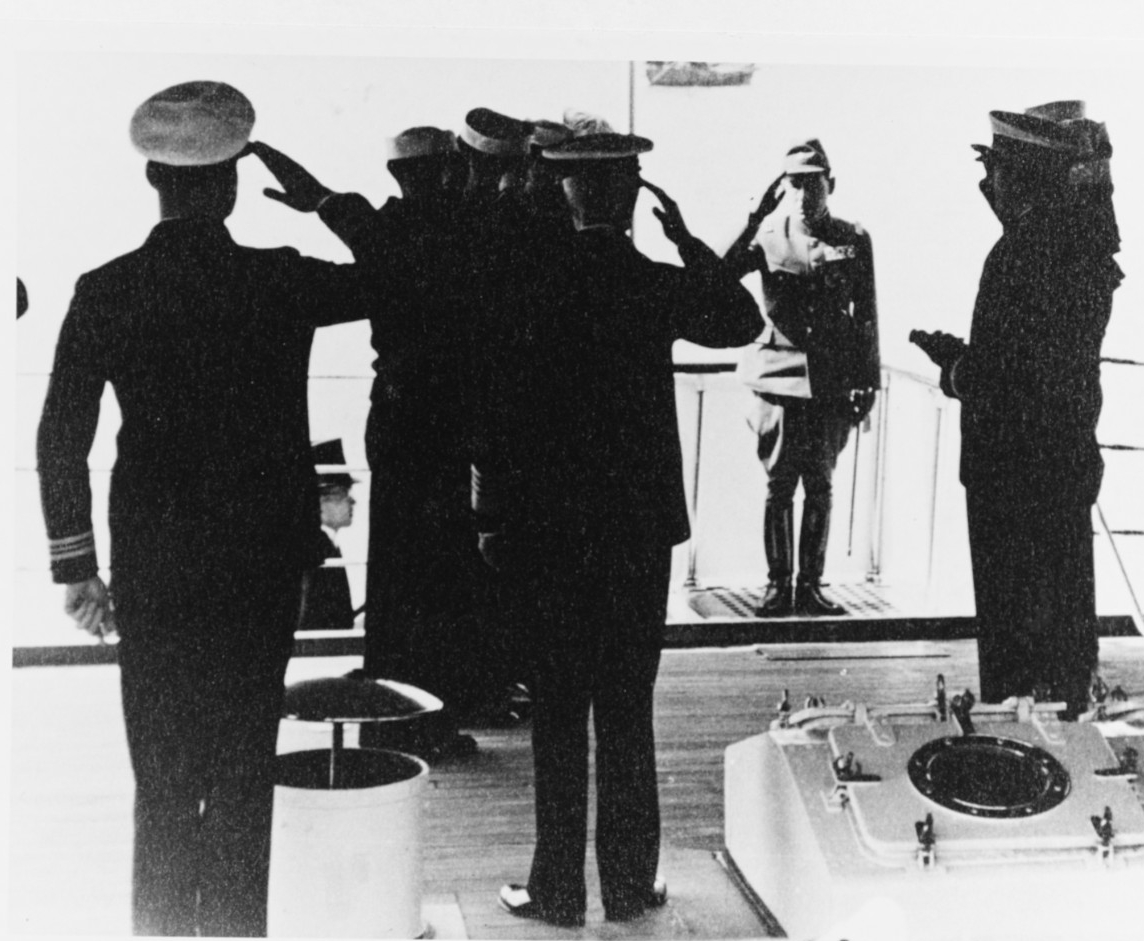
Isabel went to sea on 19 April 1938 and arrived at Chinwangtao on the 28th. The next day, she shifted back to Shanghai, arriving on 1 May. She then steamed upriver on 10 May. Bound for Nanking, she arrived on the 12th. Departing Nanking on 3 June, Isabel transited the Yangtze with an extended time in port at Shanghai (4-23 June) and shorter visits to Nanking (24-25 June) and Wuhu (25-26 June) before returning to Shanghai on the 27th. Steaming out of Shanghai on 2 July, she made her way to the Shantung Peninsula, arriving at Tsingtao the next day. She remained around Tsingtao, with the exception of a visit to Chefoo (8-15 August) and Shanghai (18-22 August), until 4 October, when she departed for Shanghai. Reaching on 5 October, she remained there through the end of the year. During this time, on 27 December, Augusta sailed again for the Philippines; once again, Adm. Yarnell remained in Shanghai with his flag in Isabel.
After the new year, Isabel got underway on 18 January 1939 bound for Wuhu (21-22 January) and then returned on the 23rd. She remained in port for almost three months, getting underway on 15 April. Steaming up the Yangtze, she arrived at Nanking on 16 April. She then moved upriver to Wuhu (17-18 April) and Hankow (21-23 April). Returning downriver, she stood into Shanghai on 26 April. She remained there until the end of May. During this time, Augusta returned from the Philippines and Adm. Yarnell transferred his flag back to the heavy cruiser. On 31 May, Isabel steamed northward to Tientsin (3-4 June) before returning to Shanghai on the 6th. Departing on 8 June, she moved to Chinwangtao (10-23 June) and Tsingtao (26 June-24 July) before returning to Shanghai on 25 July. Isabel then spent the better part of the next few months shuttling between Shanghai and Tsingtao. At Shanghai on 3 November, she steamed up the Yangtze to Chinkiang (3-4 November) and Nanking (4-6 November) on an inspection trip with Adm. Thomas C. Hart, CinCAF, who had relieved Adm. Yarnell at Shanghai in July, embarked, before returning to Shanghai on the 7th. She remained there until 22 November, when she weighed anchor and charted a course to Manila, reaching on 25 November. Clearing Manila on 7 December, she again cruised the archipelago arriving back at Manila on 16 December. She would remain there well into the next year.
Isabel got underway again on 4 March 1940, again with CinCAF embarked. She visited Pallilo (6-7 March) before returning to Manila on the 10th. Adm. Hart continued to wear his flag in Isabel during March, for cruises to Cebu, Iligan, Parang, Zamboanga, and Jolo, rejoining Augusta at Jolo on 19 March. Departing Jolo on 21 March, Isabel touched at Puerto Princesa (22-23 March) and Malampaya (23-25 March) before returning to Manila on the 26th. Adm. Hart transferred his flag to Isabel on 13 April, and visited Swatow and Amoy, ultimately rejoining Augusta and breaking his flag on board the cruiser on 22 April at Shanghai. The yacht went to sea on 27 May and returned to Shanghai on the 29th. Two days later, she steamed to Wuhu (2-10 June) and Nanking (10-11 June) before steaming back into Shanghai on the 11th. A week later she left Shanghai on 18 June and the next day arrived at Tsingtao. Clearing on 1 July, she spent the next few months shuttling between Shanghai and the Shantung Peninsula ports of Tsingtao, Chefoo, and Weiheiwei. Having arrived at Shanghai on 25 September, she remained until 10 October, when she steamed up the Yangtze. Over the next few months she transited up and down the Great River until she finally stood into Shanghai on 6 December. After six days, she made turns and got underway for Manila on 12 December, arriving three days later on the 15th.
Isabel would spend 1941 cruising the waters of the Philippines and making numerous port visits to multiple islands in the archipelago. As the threat of war with Japan grew ever larger, Isabel received instructions on 3 December 1941 to be stripped for war and fueled in four hours. She stood out of Cavite Navy Yard that same day under sealed orders from President Roosevelt to make a reconnaissance of the coast of Japanese-occupied French Indochina. Two days later, while she was off Cam Ranh Bay, [Vietnam], she was notified that a Japanese fleet was 50 miles away and closing. Isabel received orders directing her to return to Manila. On several instances during her return transit, Japanese bombers flew overhead with loaded bomb racks. Isabel was about 70 miles from Manila when the Japanese launched their surprise attack on Pearl Harbor on 8 December (local time). Adm. Hart sent the ominous message early on 8 December 1941, to the units of the Asiatic Fleet: "Japan started hostilities. Govern yourselves accordingly." Japanese planes raided Clark Field, Philippines, that same day.
Isabel continued on to Cavite, and on 10 December 1941, 68 Japanese bombers conducted an air raid on Cavite and Manila, destroying the navy yard and starting fires in the city. Isabel’s fantail was ringed by eight bombs, all of which failed to detonate. In firing in response, Isabel was credited with bringing down one of the attacking aircraft. Under the cover of darkness, she slipped out of Manila Bay in company with the submarine tender Holland (AS-3) and her vital cargo of repair and replacement parts for the submarines of the Asiatic Fleet. They, along with several other ships proceeded to the Netherlands East Indies (NEI) [Indonesia], to escape further Japanese air attacks. During that night the crew painted the ship haze gray in compliance from verbal orders from Adm. Hart who shouted the instructions from his barge as Isabel steamed out of Manila Bay. When the ship arrived at Balikpapan, Dutch Borneo, on 14 December, she had no radar, sound gear, gyrocompass, or depth charges. For the next month Isabel operated as an anti-submarine escort for convoys in the NEI, as the Allies tried desperately to stem the tide of Japanese conquest.
On the way back from a convoy escort assignment on 7 February 1942, Isabel was sent to rescue survivors from the Dutch merchantman Van Cloon near Surabaya. As she picked up the first boatload of survivors from the torpedoed and shelled vessel, the enemy submarine, I-55 (Lt. Cmdr. Nakajima Kyoji) surfaced nearby. Isabel quickly drove the submarine down with gunfire, and assisted a patrolling Consolidated PBY Catalina in dropping depth charges to drive the submarine from the area. Isabel brought 187 survivors on board. She then returned to Surabaya, DEI, where the Royal Netherlands Navy credited her with sinking the submarine.
Isabel moved on to Tjilatjap, Java, on 21 February 1942, after escorting a U.S. merchantman into the Indian Ocean via Sunda Strait. During the Battle of the Java Sea on 28 February, Isabel left her anchorage in Tjilatjap, and moored to some trees close inshore. The crew covered her with palm fronds and brush as camouflage. On 1 March, the crew cleared the vegetation and after embarking 30 radiomen with their equipment, she steamed for Fremantle, Western Australia. Departing in a raging storm, she was accompanied by the merchant ship Sea Witch. The first day out, two Japanese bombers flew over the ships and circled, but did not attack. Two days later, the main body of the convoy, only 40 miles away, was attacked by the Japanese. Asheville (PG-21) was sunk, but Isabel, protected by a heavy storm, escaped notice and was not struck. After a week of rough weather, she arrived at Fremantle on 7 March with some of her plates sprung, deck fittings broken, and with only two hours of fuel remaining. Along with repairs, which were completed on 25 March, she also underwent modification with the addition of four 20 millimeter machine guns as anti-aircraft weapons.
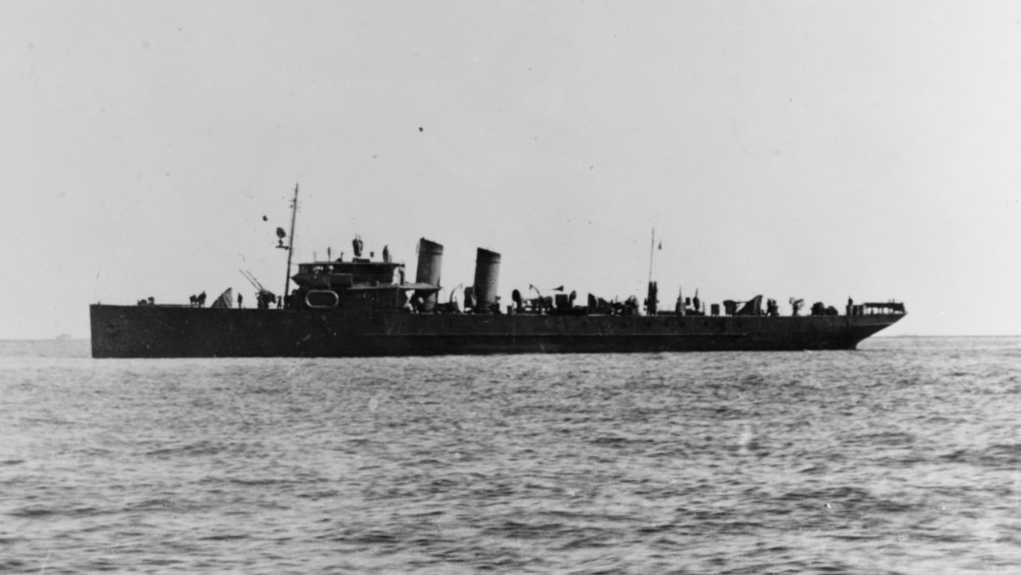
Isabel remained based at Fremantle, the home of the largest Allied submarine base in the Southern Hemisphere. She took up new duties as an escort and training ship and helped keep allied submarines in top tactical shape, and contributed to the toll taken on Japanese merchantmen and warships by them. Isabel remained on this duty until 27 August 1945, when she sailed eastward, stopping at various Pacific islands and arriving at San Francisco on 26 October 1945.
Isabel decommissioned on 11 February 1946 and was stricken from the Navy list on 26 February. She was scrapped on 25 March 1946.
Isabel received one battle star for her World War II service.
| Commanding Officers | Dates of Command |
| Lt. Cmdr. Harry E. Shoemaker | 28 December 1917 – 24 July 1918 |
| Lt. Lewis W. Comstock | 24 July 1918 – 23 February 1919 |
| Lt. Ellis H. Geiselman | 23 February – 29 April 1919 |
| Lt. Thomas N. Vinson | 29 April 1919 – 16 September 1919 |
| Cmdr. Bert B. Taylor | 16 September 1919 – 15 January 1920 |
| Lt. Ellis H. Geiselman | 15 January 1920 – 30 April 1920 |
| Lt. Cmdr. Frank Loftin | 18 July 1921 – 27 April 1923 |
| Lt. Cmdr. Robert P. Hinrichs | 27 April 1923 – 16 September 1924 |
| Lt. Philip W. Yeatman | 16 September 1924 – 22 September 1924 |
| Lt. Cmdr. Carroll M. Hall | 22 September 1924 – 14 October 1925 |
| Lt. Cmdr. Julian B. Timberlake Jr. | 14 October 1925 – 14 January 1927 |
| Cmdr. Ellis S. Stone | 14 January 1927 – 28 July 1928 |
| Lt. Cmdr. Stuart D. Truesdell | 28 July 1928 – 29 June 1929 |
| Lt. Cmdr. Lyman K. Swenson | 29 June 1929 – 11 October 1930 |
| Lt. Homer L. Grosskopf | 11 November 1930 – 25 November 1932 |
| Lt. Cmdr. Harrison Avery | 25 November 1932 – 25 September 1934 |
| Lt. Myron T. Richardson | 25 September 1934 – 21 March 1935 |
| Lt. Burton E. Rokes | 21 March 1935 – 9 December 1936 |
| Lt. Thomas L. McCann | 9 December 1936 – 16 February 1938 |
| Lt. Cmdr. Peter M. Moncy | 16 February 1938 – 17 November 1938 |
| Lt. Edwin W. Herron | 17 November 1938 – 14 August 1939 |
| Lt. Cmdr. Henry W. Goodall | 14 August 1939 – 29 December 1939 |
| Lt. Benjamin May II | 29 December 1939 – 3 September 1940 |
| Lt. Cmdr. Walter E. Linaweaver | 3 September 1940 – 2 March 1941 |
| Lt. James H. Newsome | 2 March 1941 – 2 August 1941 |
| Lt. (j.g.) James W. Payne Jr. | 2 August 1941 – 17 July 1942 |
| Lt. Franklin W. Buckley | 17 July 1942 – 1 November 1943 |
| Lt. Kenneth F. Landis | 1 November 1943 – 3 February 1944 |
| Lt. Edwin G. Zacher | 3 February 1944 – 6 June 1945 |
| Lt. Gerald C. Mitchener | 6 June 1945 – 1 August 1945 |
| Lt. Richard F. True | 1 August 1945 – 1 November 1945 |
| Lt. (j.g.) Sears R. Jayne | 1 November 1945 – 11 December 1945 |
| Lt. (j.g.) Robert J. Schostag | 11 December 1945 – 16 January 1946 |
| Lt. (j.g.) Gordon D. Danielson | 16 January 1946 – 11 February 1946 |
Christopher B. Havern Sr.
10 August 2017


